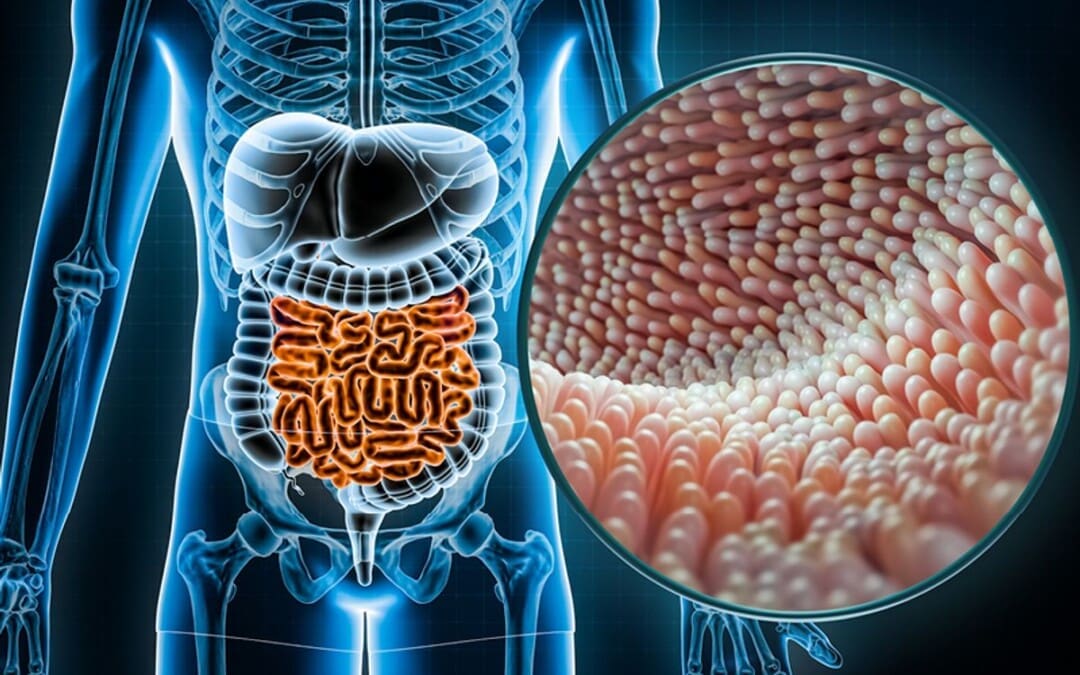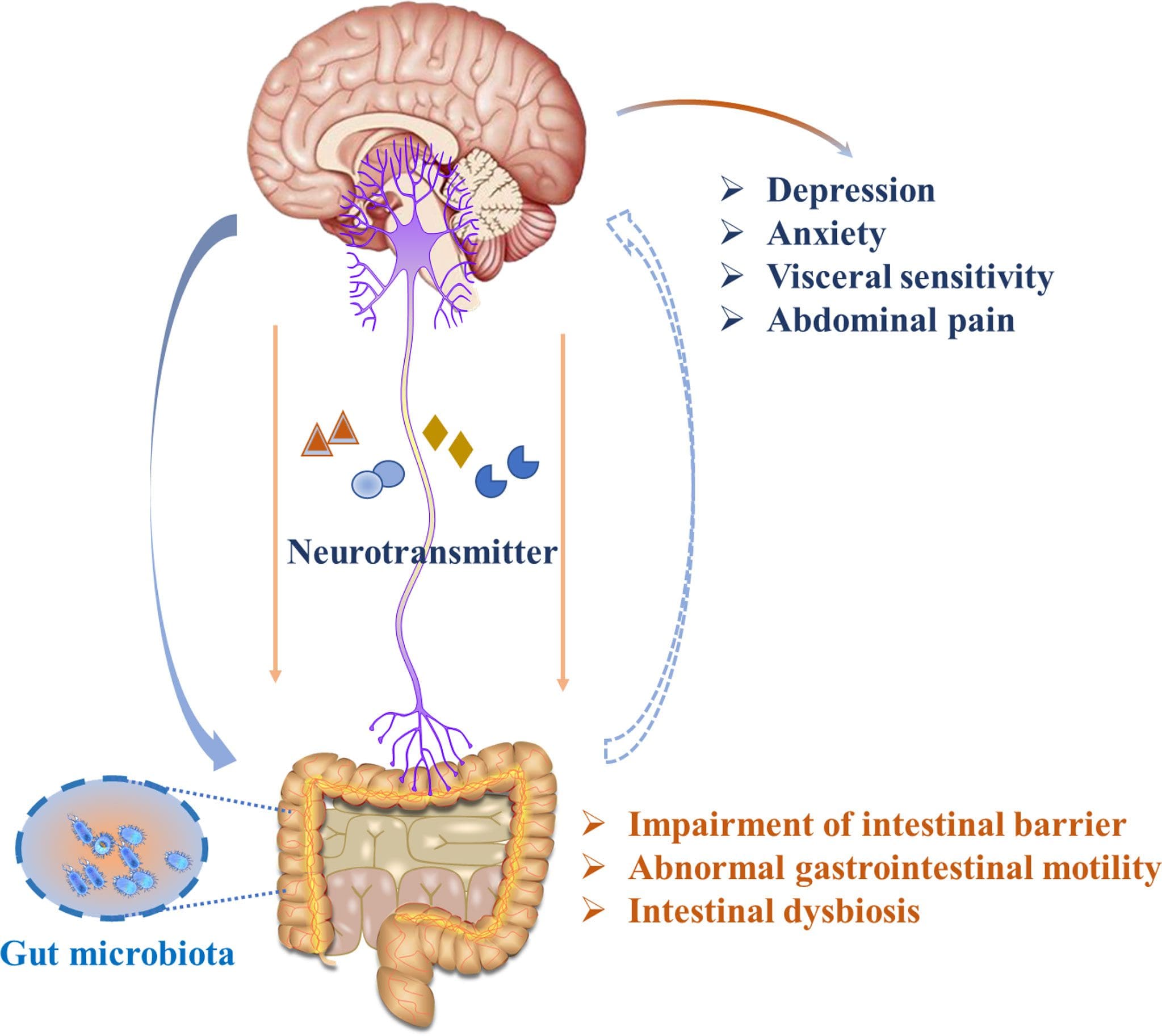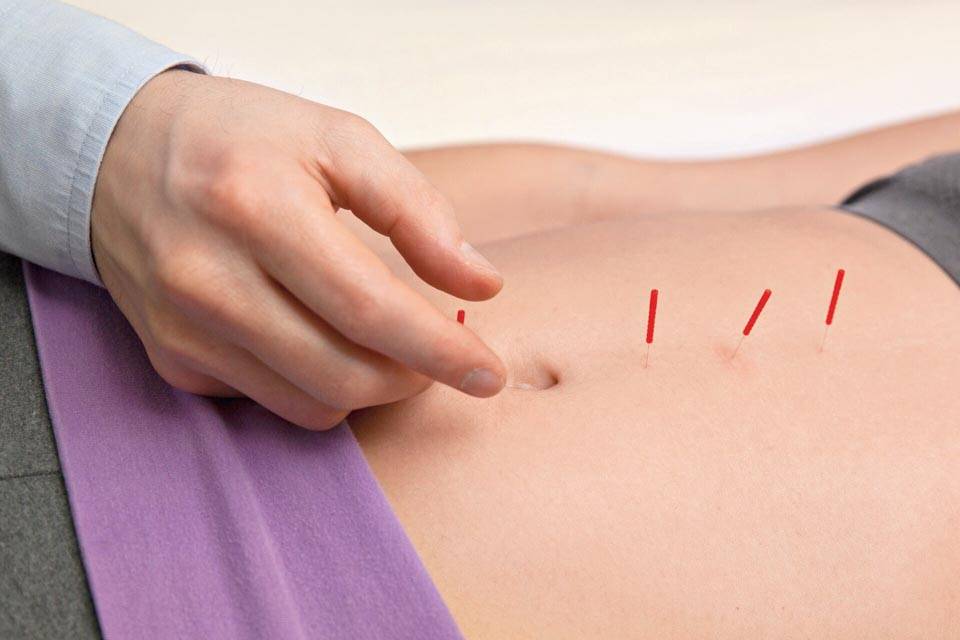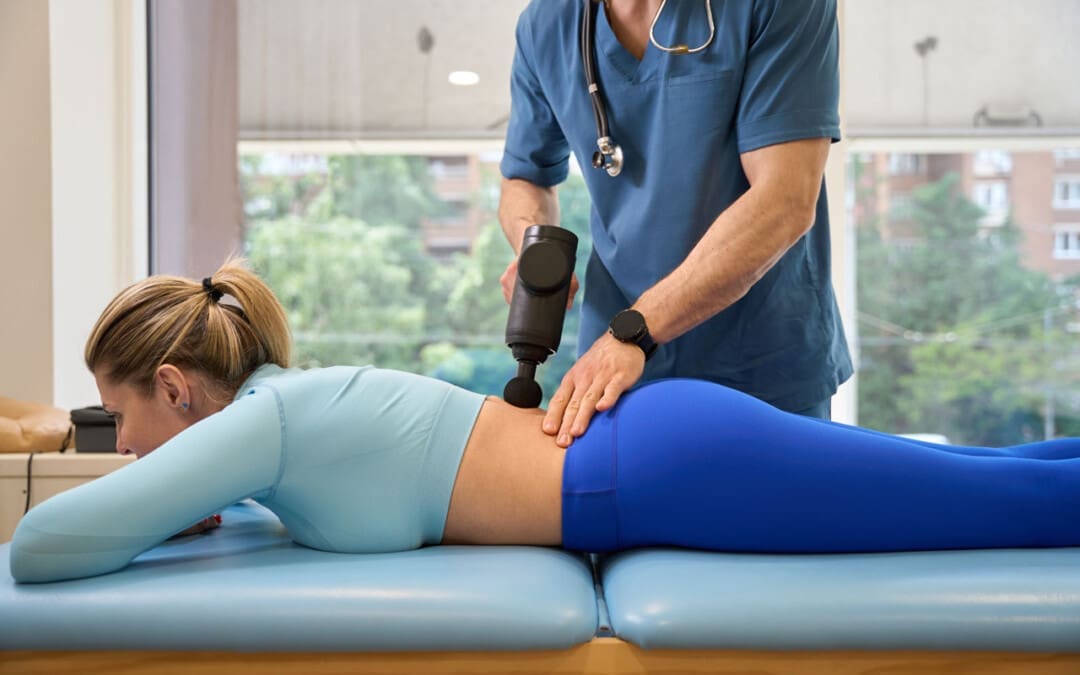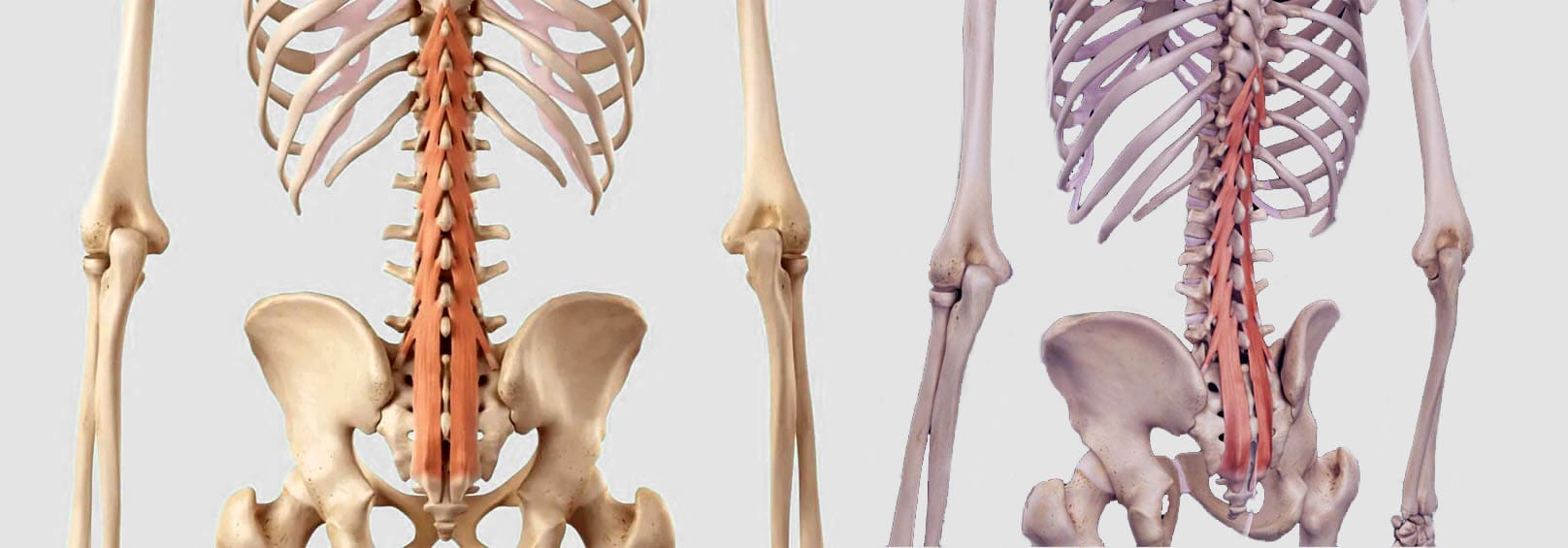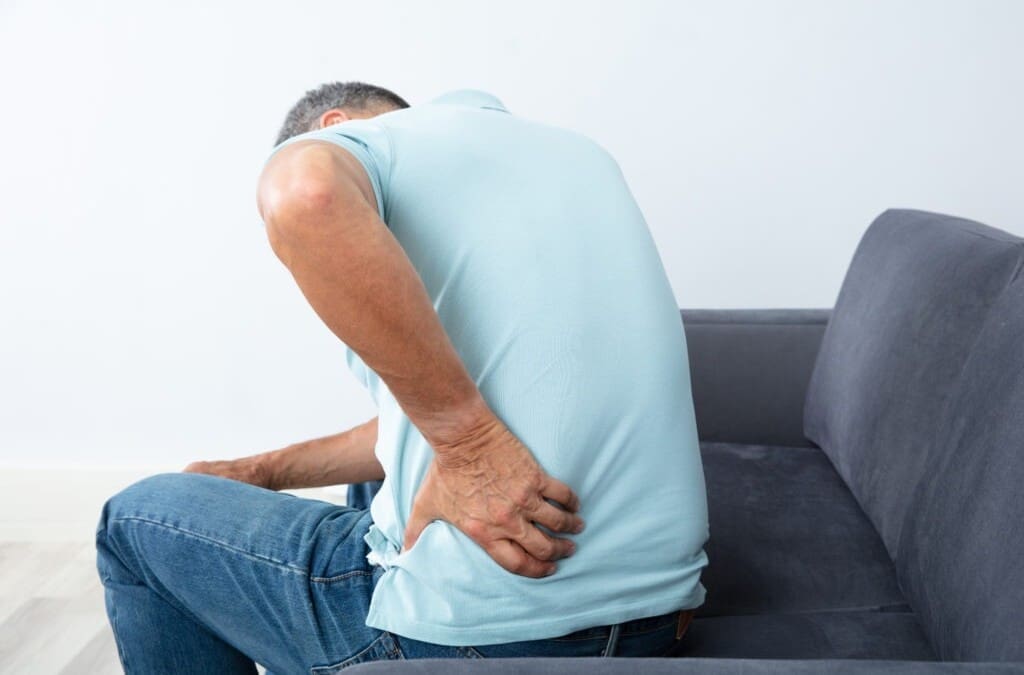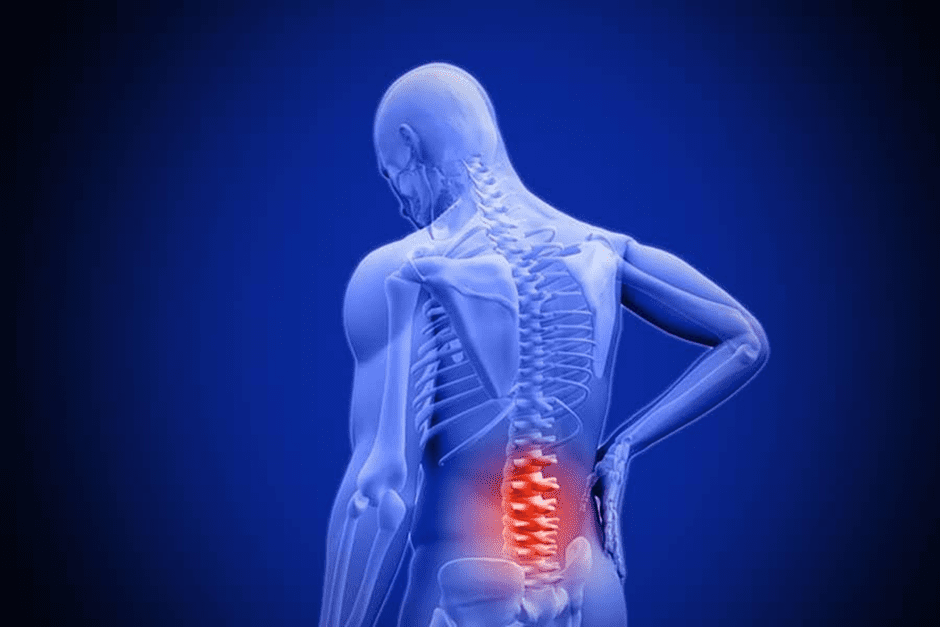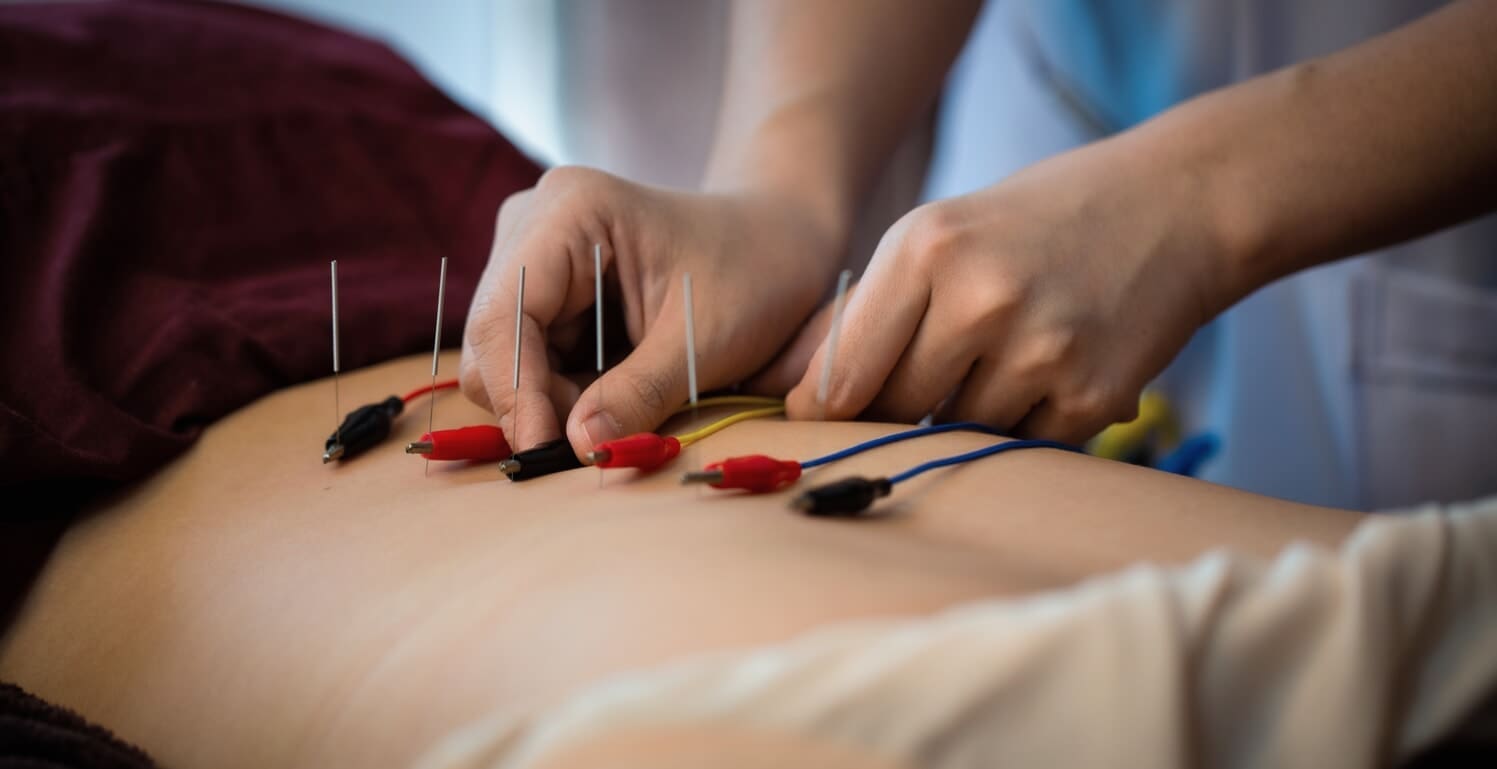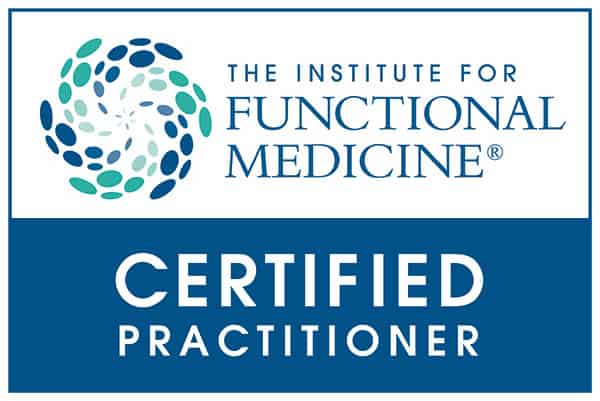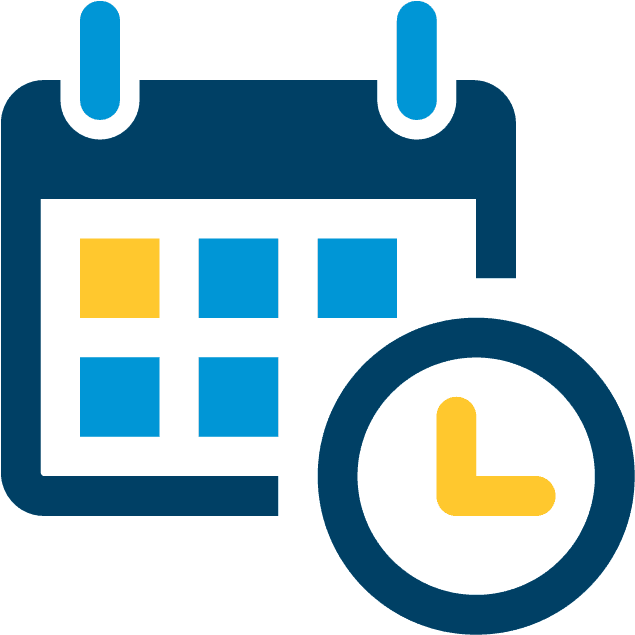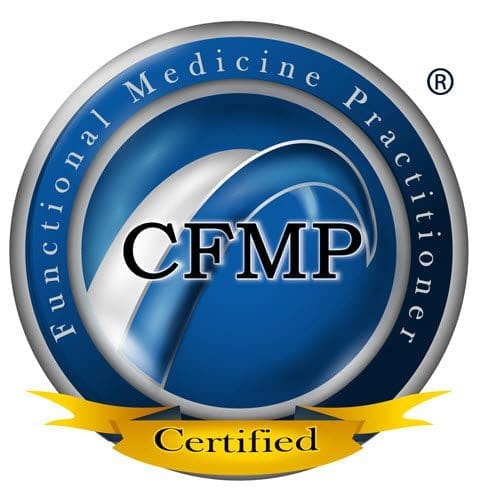ថយក្រោយឈឺ
Back Clinic ក្រុមព្យាបាលការឈឺចាប់ខ្នងផ្នែកខាងក្រោមខ្នង។ ជាង 80% នៃចំនួនប្រជាជនទទួលរងការឈឺចាប់ឆ្អឹងខ្នងនៅចំណុចខ្លះក្នុងជីវិតរបស់ពួកគេ។ ករណីភាគច្រើនអាចត្រូវបានផ្សារភ្ជាប់ទៅនឹងមូលហេតុទូទៅបំផុត: ភាពតានតឹងសាច់ដុំ របួស ឬការប្រើប្រាស់ហួសកម្រិត។ ប៉ុន្តែវាក៏អាចត្រូវបានកំណត់ថាជាលក្ខខណ្ឌជាក់លាក់នៃឆ្អឹងខ្នងផងដែរ៖ ឌីស Herniated, Degenerative Disc Disease, Spondylolisthesis, Spinal Stenosis, និង Osteoarthritis ។ លក្ខខណ្ឌទូទៅតិចជាងគឺការខូចមុខងារសន្លាក់ sacroiliac, ដុំសាច់ឆ្អឹងខ្នង, fibromyalgia និងរោគសញ្ញា piriformis ។
ការឈឺចាប់កើតឡើងដោយសារការខូចខាត ឬរបួសដល់សាច់ដុំ និងសរសៃចងនៃខ្នង។ វេជ្ជបណ្ឌិត Alex Jimenez បានចងក្រងអត្ថបទរៀបរាប់ពីសារៈសំខាន់នៃការយល់ដឹងពីមូលហេតុ និងផលប៉ះពាល់នៃរោគសញ្ញាមិនស្រួលនេះ។ Chiropractic ផ្តោតលើការស្ដារឡើងវិញនូវកម្លាំងនិងភាពបត់បែនរបស់បុគ្គលម្នាក់ ដើម្បីជួយកែលម្អរោគសញ្ញានៃការឈឺខ្នងផ្នែកខាងក្រោម។
by វេជ្ជបណ្ឌិត Alex Jimenez Chiropractic , ថយក្រោយឈឺ
Individuals may discover a lump, bump, or nodule under the skin around their lower back, hips, and sacrum that can cause pain by compressing nerves and damaging the fascia. Can knowing the conditions linked to them and their symptoms help healthcare providers determine a correct diagnosis and develop an effective treatment plan for them?
Painful Bumps, Nodules Around Low Back, Hips, and Sacrum
Painful masses in and around the hips, the sacrum , and the lower back are lumps of fat or lipomas, fibrous tissue, or other types of nodules that move when pressed on. Some healthcare providers and chiropractors, in particular, use the non-medical term back mice (In 1937, the term was used to describe lumps associated with episacroiliac lipoma) to describe the bumps. Some healthcare professionals argue against calling the masses mice because it is not specific and could lead to misdiagnoses or incorrect treatment.
Most show up in the lower back and hip area.
In some cases, they protrude or herniate through the lumbodorsal fascia or the network of connective tissue that covers the deep muscles of the lower and middle back.
Other lumps can develop in the tissue under the skin.
Today, many conditions are associated with back mice lumps, including:
Iliac crest pain syndrome
Multifidus triangle syndrome
Lumbar fascial fat herniation
Lumbosacral (sacrum) fat herniation
Episacral lipoma
លក្ខខណ្ឌពាក់ព័ន្ធ
Iliac Crest Pain Syndrome
Also known as iliolumbar syndrome, iliac crest pain syndrome develops when a tear in the ligament occurs.
The ligament band connects the fourth and fifth lumbar vertebrae with the ilium on the same side. (Dąbrowski, K. Ciszek, B. 2023 )
មូលហេតុរួមមាន :Tearing the ligament from repeated bending and twisting.
Trauma or fracture of the ilium bone caused by a fall or vehicle collision accident.
Multifidus Triangle Syndrome
Multifidus triangle syndrome develops when the multifidus muscles along the spine weaken and diminish function or ability.
These muscles can atrophy, and intramuscular fatty tissue can replace the muscle.
Atrophied muscles decrease the spine’s stability and can cause lower back pain. (Seyedhoseinpoor, T. et al., 2022 )
Lumbar Facial Fat Herniation
The lumbodorsal fascia is a thin fibrous membrane covering the back’s deep muscles.
Lumbar fascial fat herniation is a painful mass of fat that protrudes or herniates through the membrane, gets trapped and inflamed, and causes pain.
The causes of this type of herniation are currently unknown.
Lumbosacral (Sacrum) Fat Herniation
Lumbosacral describes where the lumbar spine meets the sacrum.
Lumbosacral fat herniation is a painful mass like lumbar facial herniation in a different location around the sacrum.
The causes of this type of herniation are currently unknown.
Episacral Lipoma
Episacral lipoma is a small painful nodule under the skin that primarily develops over the top outer edges of the pelvic bone. These lumps occur when a portion of the dorsal fat pad protrudes through a tear in the thoracodorsal fascia, the connective tissue that helps hold the back muscles in place. (Erdem, H. R. et al., 2013 ) A healthcare provider may refer an individual to an orthopedist or orthopedic surgeon for this lipoma. An individual may also find pain relief from a massage therapist familiar with the condition. (Erdem, H. R. et al., 2013 )
មានរោគសញ្ញា
Back lumps can often be seen under the skin. They are typically tender to the touch and can make sitting in a chair or lying on the back difficult, as they often appear on the hip bones and sacroiliac region. (Bicket, M. C. et al., 2016 ) The nodules may:
Be firm or tight.
Have an elastic feel.
Move under the skin when pressed.
Cause intense, severe pain.
The pain results from pressure on the lump, which compresses the nerves.
Damage to the underlying fascia can also cause pain symptoms.
ការធ្វើរោគវិនិច្ឆ័យ
Some individuals do not realize they have nodules or lumps until pressure is applied. Chiropractors and massage therapists often find them during treatments but do not diagnose the abnormal fatty growth. The chiropractor or massage therapist will refer the patient to a qualified dermatologist or medical professional who can perform imaging studies and a biopsy. Determining what the lumps are can be challenging because they are non-specific. Healthcare providers sometimes diagnose the nodules by injecting them with a local anesthetic. (Bicket, M. C. et al., 2016 )
ការធ្វើរោគវិនិច្ឆ័យឌីផេរ៉ង់ស្យែល
The fatty deposits can be any number of things, and the same applies to the sources of nerve pain. A healthcare provider may further diagnose by ruling out other causes, which can include:
Sebaceous Cysts
A benign, fluid-filled capsule between the layers of skin.
Subcutaneous Abscess
A collection of pus beneath the skin.
Usually painful.
It can become inflamed.
Sciatica
Radiating nerve pain down one or both legs that is caused by a herniated disc, bone spur, or spasming muscles in the lower back.
Liposarcoma
Malignant tumors can sometimes appear as fatty growths in the muscles.
Liposarcoma is typically diagnosed by biopsy, where some tissue is removed from the nodule and examined for cancer cells. (Johns Hopkins Medicine. 2024)
An MRI or CT scan may also be performed to determine the exact location of the nodule.
Painful lipomas are also associated with fibromyalgia.
ការព្យាបាល
Back nodules are usually benign, so there’s no reason to remove them unless they’re causing pain or mobility problems (American Academy of Orthopedic Surgeons: OrthoInfo. 2023 ). However, they should be examined to make sure they are not cancerous. Treatment usually involves injected anesthetics, such as lidocaine or corticosteroids, as well as over-the-counter pain relievers like NSAIDs.
ការវះកាត់
If pain is severe, surgical removal may be recommended. This involves cutting out the mass and repairing the fascia for lasting relief. However, removal may not be recommended if there are many nodules, as some individuals can have hundreds. Liposuction may be effective if the lumps are smaller, more extensive, and comprise more fluid. (American Family Physician. 2002 ) Complications of surgical removal can include:
ស្លាកស្នាម
ស្នាមរបួស
វាយនភាពស្បែកមិនស្មើគ្នា
ការឆ្លង
Complementary and Alternative Treatment
Complimentary and Alternative Medicine treatments like acupuncture, dry needling, and spinal manipulation can help. Many chiropractors believe back nodules can be successfully treated with complementary and alternative therapies. A common approach uses acupuncture and spinal manipulation in combination. A case study reported that anesthetic injections followed by dry needling, which is similar to acupuncture, improved pain relief. (Bicket, M. C. et al., 2016 )
Injury Medical Chiropractic and Functional Medicine Clinic specializes in progressive therapies and functional rehabilitation procedures focused on restoring normal body functions after trauma and soft tissue injuries and the complete recovery process. Our areas of practice include Wellness & Nutrition, Chronic Pain, Personal Injury, Auto Accident Care, Work Injuries, Back Injury, Low Back Pain, Neck Pain, Migraine Headaches, Sports Injuries, Severe Sciatica, Scoliosis, Complex Herniated Discs, Fibromyalgia, Chronic Pain, Complex Injuries, Stress Management, Functional Medicine Treatments, and in-scope care protocols. If the individual requires other treatment, they will be referred to a clinic or physician best suited for their condition, as Dr. Jimenez has teamed with the top surgeons, clinical specialists, medical researchers, therapists, trainers, and premiere rehabilitation providers.
លើសពីផ្ទៃ
VIDEO
ឯកសារយោង
Dąbrowski, K., & Ciszek, B. (2023). Anatomy and morphology of iliolumbar ligament. Surgical and radiologic anatomy : SRA, 45(2), 169–173. doi.org/10.1007/s00276-022-03070-y
Seyedhoseinpoor, T., Taghipour, M., Dadgoo, M., Sanjari, M. A., Takamjani, I. E., Kazemnejad, A., Khoshamooz, Y., & Hides, J. (2022). Alteration of lumbar muscle morphology and composition in relation to low back pain: a systematic review and meta-analysis. The spine journal : official journal of the North American Spine Society, 22(4), 660–676. doi.org/10.1016/j.spinee.2021.10.018
Erdem, H. R., Nacır, B., Özeri, Z., & Karagöz, A. (2013). Episakral lipoma: Bel ağrısının tedavi edilebilir bir nedeni [Episacral lipoma: a treatable cause of low back pain]. Agri : Agri (Algoloji) Dernegi’nin Yayin organidir = The journal of the Turkish Society of Algology, 25(2), 83–86. doi.org/10.5505/agri.2013.63626
Bicket, M. C., Simmons, C., & Zheng, Y. (2016). The Best-Laid Plans of “Back Mice” and Men: A Case Report and Literature Review of Episacroiliac Lipoma. Pain physician, 19(3), 181–188.
Johns Hopkins Medicine. (2024). Liposarcoma. www.hopkinsmedicine.org/health/conditions-and-diseases/sarcoma/liposarcoma
American Academy of Orthopedic Surgeons: OrthoInfo. (2023). Lipoma. orthoinfo.aaos.org/en/diseases–conditions/lipoma
American Family Physician. (2002). Lipoma excision. American Family Physician, 65(5), 901-905. www.aafp.org/pubs/afp/issues/2002/0301/p901.html
by វេជ្ជបណ្ឌិត Alex Jimenez ជើងអូតូអូទិក , ថយក្រោយឈឺ
ស្បែកជើងអាចបណ្តាលឱ្យឈឺខ្នងផ្នែកខាងក្រោម និងបញ្ហាសម្រាប់បុគ្គលមួយចំនួន។ តើការយល់ដឹងអំពីទំនាក់ទំនងរវាងស្បែកជើង និងបញ្ហាខ្នងអាចជួយឱ្យបុគ្គលស្វែងរកស្បែកជើងត្រឹមត្រូវដើម្បីថែរក្សាសុខភាពខ្នង និងបំបាត់ការឈឺចាប់បានទេ?
ស្បែកជើងឈឺខ្នង
ខ្នងផ្តល់នូវកម្លាំងសម្រាប់សកម្មភាពរាងកាយ។ ការឈឺខ្នងប៉ះពាល់ដល់ជីវិតប្រចាំថ្ងៃ ហើយអាចមានមូលហេតុផ្សេងៗ។ ឥរិយាបថមិនមានសុខភាពល្អ ការដើរ រមួលបង្វែរ ការបត់ជើង និងការឈានដល់អាចរួមចំណែកដល់បញ្ហាខ្នងដែលបណ្តាលឱ្យមានការឈឺចាប់។ យោងតាម CDC មនុស្សពេញវ័យ 39% រាយការណ៍ថារស់នៅជាមួយការឈឺខ្នង (មជ្ឈមណ្ឌលគ្រប់គ្រងនិងបង្ការជំងឺ, អេស។ ស។ អ ) ការពាក់ស្បែកជើងមិនត្រឹមត្រូវក៏អាចរួមចំណែកដល់ការឈឺខ្នងផងដែរ។ ការជ្រើសរើសស្បែកជើងដោយប្រុងប្រយ័ត្នអាចជួយបន្ថយការឈឺចាប់ និងជួយរក្សាសុខភាពឆ្អឹងខ្នង។ បុគ្គលម្នាក់ៗអាចរីករាយនឹងការឈឺចាប់តិច និងគ្រប់គ្រងរោគសញ្ញាដោយជ្រើសរើសស្បែកជើងដែលរក្សាការតម្រឹមឆ្អឹងខ្នង និងការពារជើងពីការប៉ះទង្គិចត្រង់ៗ។
ស្វែងយល់ពីការឈឺខ្នង-ការភ្ជាប់ស្បែកជើង
ការពាក់ស្បែកជើងមិនត្រឹមត្រូវអាចជាមូលហេតុនៃការឈឺខ្នងផ្នែកខាងក្រោម។ អ្វីដែលប៉ះពាល់ដល់ឆ្អឹងនៅផ្នែកខាងក្រោមនៃប្រព័ន្ធ neuromusculoskeletal បញ្ចេញរស្មីឡើងលើ និងប៉ះពាល់ដល់ឆ្អឹងខ្នង និងសាច់ដុំខ្នង។ ស្បែកជើងណាដែលត្រូវបានប្រើធ្វើដំណើរឡើងលើ ប៉ះពាល់ដល់ការដើរ ឥរិយាបថ ការតម្រឹមឆ្អឹងខ្នង និងច្រើនទៀត។ នៅពេលដែលបញ្ហាខ្នងមានប្រភពចេញពីជើង ទាំងនេះគឺជាបញ្ហាជីវមេកានិក។ Biomechanics មានន័យថារបៀបដែលឆ្អឹង សន្លាក់ និងសាច់ដុំធ្វើការជាមួយគ្នា និងរបៀបដែលការផ្លាស់ប្តូរនៃកម្លាំងខាងក្រៅមានឥទ្ធិពលលើរាងកាយ។
ចលនា
នៅពេលដែលជើងប៉ះនឹងដី វាគឺជាចុងដំបូងបង្អស់ដែលស្រូបឆក់សម្រាប់រាងកាយដែលនៅសល់។ បុគ្គលនឹងចាប់ផ្តើមដើរខុសពីគេ ប្រសិនបើពួកគេមានបញ្ហា ឬផ្លាស់ប្តូរជើងរបស់ពួកគេ។ ការពាក់ស្បែកជើងជាមួយនឹងការគាំទ្រមិនត្រឹមត្រូវអាចបង្កើនការពាក់ និងការរហែកនៅលើសាច់ដុំ និងសន្លាក់ ដែលនាំឱ្យមានចលនាឆ្គង និងខុសពីធម្មជាតិ។ ជាឧទាហរណ៍ សូមពិចារណាពីភាពខុសគ្នារវាងការឈរនៅលើជើងកែងជើងក្នុងស្បែកជើងកែងខ្ពស់ និងស្ថានភាពជើងរាបស្មើ។ ស្បែកជើងដែលមានខ្នើយល្អ ជួយស្រូបយកផលប៉ះពាល់ និងកាត់បន្ថយអារម្មណ៍ឈឺចាប់។ សម្ពាធលើសន្លាក់នីមួយៗផ្លាស់ប្តូរតុល្យភាព ដែលបណ្តាលឱ្យមានបញ្ហាអស្ថិរភាព ជាមួយនឹងសម្ពាធតិចលើផ្នែកខ្លះ និងច្រើនលើផ្នែកផ្សេងទៀត។ នេះបង្កើតអតុល្យភាពដែលនាំឱ្យមានការឈឺចាប់ និងលក្ខខណ្ឌសន្លាក់។
រូបភាព
ការរក្សាឥរិយាបថឱ្យមានសុខភាពល្អគឺជាកត្តាមួយទៀតក្នុងការការពារឬកាត់បន្ថយការឈឺខ្នង។ ជាមួយនឹងស្បែកជើងត្រឹមត្រូវ រាងកាយអាចរក្សាជំហរដែលមានសុខភាពល្អ និងកោងត្រឹមត្រូវនៅទូទាំងឆ្អឹងខ្នង ហើយវាជួយចែកចាយទម្ងន់ឱ្យស្មើគ្នា។ នេះបណ្តាលឱ្យមានការថយចុះភាពតានតឹងលើសរសៃចង សាច់ដុំ និងសន្លាក់។ (ការបោះពុម្ពផ្សាយសុខភាពរបស់ហាវ៉ាដ។ ២០២២ ) វាត្រូវបានផ្ដល់អនុសាសន៍ឱ្យទៅជួបគ្រូពេទ្យជំនាញខាងឆ្អឹង ដើម្បីឈានដល់ឫសគល់នៃស្ថានភាពបុគ្គល។ សម្រាប់អ្នកខ្លះ ឌីស herniated, sciatica, ការប៉ះទង្គិចរថយន្ត, ការដួលរលំ, ergonomics មិនល្អ ឬការរួមបញ្ចូលគ្នា ក៏ដូចជាបញ្ហាមូលដ្ឋានផ្សេងទៀត អាចរួមចំណែកដល់ការឈឺខ្នងរបស់ពួកគេ។
របៀបដែលស្បែកជើងផ្សេងៗប៉ះពាល់ដល់ឥរិយាបថ ដែលអាចបណ្តាលឱ្យ ឬបន្ថយការឈឺខ្នង។
ស្បែកជើងកែង
ស្បែកជើងកែងជើងខ្ពស់ពិតជាអាចរួមចំណែកដល់ការឈឺខ្នង។ ពួកគេផ្លាស់ប្តូរឥរិយាបថរាងកាយ បណ្តាលឱ្យមានឥទ្ធិពល domino នៅលើឆ្អឹងខ្នង។ ទម្ងន់របស់រាងកាយត្រូវបានផ្លាស់ប្តូរដើម្បីបង្កើនសម្ពាធលើបាល់នៃជើង ហើយការតម្រឹមរបស់ឆ្អឹងខ្នងបានផ្លាស់ប្តូរ។ ស្បែកជើងកែងជើងខ្ពស់ក៏ប៉ះពាល់ដល់របៀបដែលកជើង ជង្គង់ និងត្រគាកធ្វើចលនានៅពេលដើរ តុល្យភាព និងរបៀបដែលសាច់ដុំខ្នងដំណើរការ ដែលទាំងអស់នេះអាចធ្វើឱ្យឈឺខ្នងកាន់តែធ្ងន់ធ្ងរ។
ស្បែកជើងរាបស្មើ
ស្បែកជើងសំប៉ែតប្រហែលជាមិនមែនជាជម្រើសដ៏ល្អបំផុតសម្រាប់សុខភាពឆ្អឹងខ្នងនោះទេ។ ប្រសិនបើពួកគេខ្វះផ្នែកទ្រទ្រង់ ពួកគេអាចបណ្តាលឱ្យជើងរមៀលចូល ឬហៅថា pronation។ នេះអាចរួមចំណែកដល់ការតម្រឹមមិនត្រឹមត្រូវ ដែលអាចធ្វើឱ្យជង្គង់ ត្រគាក និងខ្នងទាប។ ទោះយ៉ាងណាក៏ដោយ ពួកគេអាចជាជម្រើសដ៏សមរម្យមួយ ប្រសិនបើពួកគេផ្តល់ការគាំទ្រផ្នែករឹង។ នៅពេលពាក់ស្បែកជើងសំប៉ែតជាមួយនឹងជំនួយសុខភាព ទម្ងន់ត្រូវបានចែកចាយរាបស្មើនៅលើជើង និងឆ្អឹងខ្នង។ នេះជួយរក្សាឥរិយាបថត្រឹមត្រូវ ដែលអាចជួយការពារ និង/ឬកាត់បន្ថយការឈឺខ្នង។
ស្បែកជើងប៉ាតា វាយកូនបាល់ និងស្បែកជើងកីឡា
ស្បែកជើងប៉ាតា កីឡាវាយកូនបាល់ និង ស្បែកជើងកីឡា អាចបំបាត់ការឈឺខ្នងដោយប្រើខ្នើយ និងជំនួយយ៉ាងហ្មត់ចត់។ ការជ្រើសរើសត្រឹមត្រូវពាក់ព័ន្ធនឹងការកំណត់សកម្មភាពដែលនឹងត្រូវធ្វើនៅក្នុងពួកគេ។ មានកីឡាវាយកូនបាល់ រត់ បាល់បោះ បាល់បោះ ស្បែកជើងជិះស្គី និងច្រើនទៀត។ ស្រាវជ្រាវថាតើលក្ខណៈពិសេសអ្វីខ្លះដែលត្រូវការសម្រាប់កីឡា ឬសកម្មភាព។ នេះអាចរួមបញ្ចូលៈ
ពែងកែងជើង
ទ្រនាប់ទ្រនាប់
មូលដ្ឋានធំទូលាយ
លក្ខណៈពិសេសផ្សេងទៀតដើម្បីបំពេញតម្រូវការជើងបុគ្គល។
វាត្រូវបានណែនាំឱ្យផ្លាស់ប្តូរស្បែកជើងកីឡារៀងរាល់ 300 ទៅ 500 ម៉ាយល៍នៃការដើរ ឬរត់ ឬដោយមានសញ្ញានៃភាពមិនស្មើគ្នានៅពេលដាក់លើផ្ទៃរាបស្មើ ព្រោះស្បែកជើងដែលពាក់ចេញ និងសម្ភារៈដែលខូចអាចបង្កើនហានិភ័យនៃការរងរបួស និងឈឺខ្នង។ (American Academy of Podiatric Sports Medicine ឆ្នាំ 2024 ) ប្រសិនបើគូជាក់លាក់មួយដាក់ជើង ត្រគាក ឬកជើងទៅក្នុងទីតាំងខុសពីធម្មជាតិ ឬរារាំងចលនាទៀងទាត់ វាអាចដល់ពេលដែលត្រូវជំនួសពួកគេ។
ការជ្រើសរើសស្បែកជើងត្រឹមត្រូវ។
ដំណោះស្រាយដ៏ល្អសម្រាប់ការជ្រើសរើសពាក់ស្បែកជើងគឺដើម្បីទទួលបានការវិភាគអំពីការដើរ និងការពិនិត្យមើលពីរបៀបដែលអ្នកដើរ និងរត់។ អ្នកជំនាញផ្នែកថែទាំសុខភាពផ្សេងៗអាចផ្តល់សេវាកម្មនេះដើម្បីកែសម្រួលការស្វែងរករបស់បុគ្គលម្នាក់ៗសម្រាប់ស្បែកជើងដែលត្រឹមត្រូវសម្រាប់ការឈឺខ្នង។ នៅក្នុងការវិភាគការដើរ បុគ្គលត្រូវបានស្នើសុំឱ្យរត់ និងដើរ ជួនកាលនៅលើកាមេរ៉ា ខណៈពេលដែលអ្នកជំនាញកត់សម្គាល់ពីទំនោររាងកាយ ដូចជាពេលដែលជើងប៉ះនឹងដី និងថាតើវារមៀលចូល ឬខាងក្រៅ។ វាផ្តល់នូវទិន្នន័យអំពីឥរិយាបថ ចលនា កម្រិតនៃការឈឺចាប់ ថាតើត្រូវការជំនួយផ្នែកក្លៀកប៉ុន្មាន និងប្រភេទណាដែលត្រូវពាក់ ដើម្បីជួយការពារការឈឺខ្នង។ នៅពេលដែលការវិភាគត្រូវបានបញ្ចប់ វានឹងណែនាំអ្នកអំពីអ្វីដែលត្រូវរកមើល ដូចជាកម្រិតនៃការទ្រទ្រង់ក្លោងទ្វារ កម្ពស់កែងជើង ឬសម្ភារៈណាដែលល្អបំផុតសម្រាប់អ្នក។
គ្លីនិកព្យាបាលរបួស និងឱសថព្យាបាលរបួសមានឯកទេសក្នុងការព្យាបាលជឿនលឿន ទំនើប និងនីតិវិធីស្តារនីតិសម្បទាដែលផ្តោតលើសរីរវិទ្យាគ្លីនិក សុខភាពសរុប ការបណ្តុះបណ្តាលកម្លាំងជាក់ស្តែង និងការធ្វើឱ្យមានលក្ខខណ្ឌពេញលេញ។ យើងផ្តោតលើការស្តារមុខងាររាងកាយធម្មតាឡើងវិញ បន្ទាប់ពីរបួស និងរបួសជាលិកាទន់។ យើងប្រើពិធីការ Chiropractic ឯកទេស កម្មវិធីសុខភាព កម្មវិធីអាហារូបត្ថម្ភមុខងារ និងរួមបញ្ចូលគ្នា ការបណ្តុះបណ្តាលកាយសម្បទា ភាពរហ័សរហួន និងចល័ត និងប្រព័ន្ធស្តារនីតិសម្បទាសម្រាប់គ្រប់វ័យ។ កម្មវិធីរបស់យើងមានលក្ខណៈធម្មជាតិ ហើយប្រើប្រាស់សមត្ថភាពរបស់រាងកាយដើម្បីសម្រេចបាននូវគោលដៅដែលបានវាស់វែងជាក់លាក់ ជាជាងការណែនាំអំពីសារធាតុគីមីដែលបង្កគ្រោះថ្នាក់ ការជំនួសអរម៉ូនដ៏ចម្រូងចម្រាស ការវះកាត់ដែលមិនចង់បាន ឬថ្នាំញៀន។ យើងបានសហការជាមួយវេជ្ជបណ្ឌិត អ្នកព្យាបាលរោគ និងអ្នកបណ្តុះបណ្តាលសំខាន់ៗរបស់ទីក្រុង ដើម្បីផ្តល់នូវការព្យាបាលដែលមានគុណភាពខ្ពស់ ដែលផ្តល់សិទ្ធិអំណាចដល់អ្នកជំងឺរបស់យើងក្នុងការរក្សារបៀបរស់នៅប្រកបដោយសុខភាពល្អបំផុត និងរស់នៅប្រកបដោយមុខងារជាមួយនឹងថាមពលកាន់តែច្រើន អាកប្បកិរិយាវិជ្ជមាន ការគេងបានល្អប្រសើរ និងការឈឺចាប់តិច។ .
អត្ថប្រយោជន៍នៃការប្រើជើងអ័រតូទិកផ្ទាល់ខ្លួន
VIDEO
ឯកសារយោង
មជ្ឈមណ្ឌលគ្រប់គ្រង និងបង្ការជំងឺ។ (2019)។ ឆ្អឹងខ្នង អវយវៈក្រោម និងការឈឺចាប់អវយវៈខាងលើក្នុងចំណោមមនុស្សពេញវ័យនៅសហរដ្ឋអាមេរិក ឆ្នាំ 2019។ ទាញយកមកពី www.cdc.gov/nchs/products/databriefs/db415.htm
ការបោះពុម្ពផ្សាយសុខភាពរបស់ហាវ៉ាដ។ (២០១៤)។ ឥរិយាបថ និងសុខភាពខ្នង។ ការអប់រំសុខភាពនៅហាវ៉ាដ។ www.health.harvard.edu/pain/posture-and-back-health
បណ្ឌិតសភាវេជ្ជសាស្ត្រកីឡា Podiatric អាមេរិក។ Ayne Furman, DF, AAPSM ។ (២០២៤)។ តើខ្ញុំដឹងដោយរបៀបណាថាវាដល់ពេលដែលត្រូវជំនួសស្បែកជើងកីឡារបស់ខ្ញុំ?
by វេជ្ជបណ្ឌិត Alex Jimenez ឈឺខ្នង , Chiropractic , ការឈឺចាប់រ៉ាំរ៉ៃ , ថយក្រោយឈឺ , ការព្យាបាលការបង្ហាប់ឆ្អឹងខ្នង , ការព្យាបាល , ការឆ្លុះបញ្ចាំង Viscerosomatic
តើបុគ្គលដែលមានជំងឺសរសៃពួរឆ្អឹងខ្នងអាចប្រើការបង្ហាប់ឆ្អឹងខ្នងដើម្បីកាត់បន្ថយការឈឺខ្នងទាប និងស្តារភាពចល័តបានទេ?
សេចក្តីផ្តើម
បុគ្គលជាច្រើននៅទូទាំងពិភពលោកបានដោះស្រាយការឈឺខ្នងទាបនៅចំណុចខ្លះក្នុងជីវិតរបស់ពួកគេ ដែលប៉ះពាល់ដល់ការចល័តរបស់ពួកគេ និងប៉ះពាល់ដល់ទម្លាប់របស់ពួកគេ។ កត្តាបរិស្ថានជាច្រើនអាចនាំឱ្យមានការវិវឌ្ឍន៍នៃការឈឺឆ្អឹងខ្នងទាប ដូចជាការលើកធ្ងន់មិនត្រឹមត្រូវ ឥរិយាបថមិនល្អ របួសផ្លូវចិត្ត និងគ្រោះថ្នាក់ដែលអាចប៉ះពាល់ដល់សាច់ដុំជុំវិញ ខួរឆ្អឹងខ្នង និងឫសសរសៃប្រសាទ។ នៅពេលដែលវាកើតឡើង វាអាចនាំអោយមានការក្រិនឆ្អឹងខ្នង និងបណ្តាលឱ្យមានទម្រង់ហានិភ័យត្រួតស៊ីគ្នា ដែលទាក់ទងនឹងការឈឺឆ្អឹងខ្នងទាប។ នៅពេលដែលមនុស្សកំពុងដោះស្រាយជាមួយនឹងជំងឺសរសៃពួរឆ្អឹងខ្នង ពួកគេអាចគិតថាការឈឺចាប់របស់ពួកគេគឺនៅផ្នែកខាងក្រោម។ ដល់ចំណុចនោះ បុគ្គលជាច្រើនស្វែងរកការព្យាបាលមិនត្រឹមតែកាត់បន្ថយការឈឺឆ្អឹងខ្នងទាបប៉ុណ្ណោះទេ ប៉ុន្តែថែមទាំងកាត់បន្ថយផលប៉ះពាល់នៃការក្រិនឆ្អឹងខ្នងផងដែរ។ ការព្យាបាលមួយចំនួន ដូចជាការបង្ហាប់ឆ្អឹងខ្នង ដែលជាការព្យាបាលមិនវះកាត់ អាចជួយស្តារភាពចល័តដល់រាងកាយ។ អត្ថបទថ្ងៃនេះមើលពីរបៀបដែល lumbar spinal stenosis ប៉ះពាល់ដល់ខ្នងផ្នែកខាងក្រោម និងការធ្វើរោគវិនិច្ឆ័យរបស់វា ខណៈពេលដែលមើលពីរបៀបដែលការបង្ហាប់ឆ្អឹងខ្នងអាចផ្តល់ភាពធូរស្រាលដល់បុគ្គល និងមានអត្ថប្រយោជន៍ជាវិជ្ជមានក្នុងការស្តារការចល័តឡើងវិញ។ យើងនិយាយជាមួយអ្នកផ្តល់សេវាវេជ្ជសាស្រ្តដែលមានការបញ្ជាក់ដែលបង្រួបបង្រួមព័ត៌មានអ្នកជំងឺរបស់យើងដើម្បីវាយតម្លៃពីរបៀបដែលជំងឺសរសៃពួរឆ្អឹងខ្នងទាក់ទងនឹងការឈឺខ្នងផ្នែកខាងក្រោម ដែលបណ្តាលឱ្យមានបញ្ហាចល័ត។ យើងក៏ជូនដំណឹង និងណែនាំអ្នកជំងឺអំពីរបៀបដែលការបង្ហាប់ឆ្អឹងខ្នងគឺជាទម្រង់នៃការព្យាបាលដ៏ល្អ ដែលអាចរួមបញ្ចូលគ្នាជាមួយនឹងការព្យាបាលផ្សេងទៀត។ យើងលើកទឹកចិត្តអ្នកជំងឺរបស់យើងឱ្យសួរអ្នកផ្តល់សេវាវេជ្ជសាស្រ្តដែលពាក់ព័ន្ធរបស់ពួកគេនូវសំណួរដ៏ស្មុគស្មាញ និងសំខាន់ៗអំពីការរួមបញ្ចូលការព្យាបាលដោយការបង្ហាប់ដើម្បីបន្ថយផលប៉ះពាល់នៃការឈឺចាប់ដែលបណ្តាលមកពីការក្រិនចង្កេះ ខណៈពេលដែលកាត់បន្ថយផលប៉ះពាល់នៃការឈឺចាប់ដែលត្រួតគ្នាដូចជាការឈឺខ្នងផ្នែកខាងក្រោម ដើម្បីទទួលបានការចល័តរបស់មនុស្សឡើងវិញ។ វេជ្ជបណ្ឌិត Jimenez, DC, រួមបញ្ចូលព័ត៌មាននេះជាសេវាកម្មសិក្សា។ ការមិនទទួលខុសត្រូវ .
របៀបដែលជម្ងឺសរសៃពួរឆ្អឹងខ្នងប៉ះពាល់ដល់ផ្នែកខាងក្រោមខ្នង
តើអ្នកមានអារម្មណ៍ញ័រនៅផ្នែកខាងក្រោយនៃជើងរបស់អ្នកដែលប៉ះពាល់ដល់សមត្ថភាពធ្វើចលនាឬទេ? ឬតើខ្នងខាងក្រោមរបស់អ្នកមានអារម្មណ៍ថាចល័តតិចជាងវាធ្លាប់ប្រើដែរឬទេ? នៅពេលដែលបុគ្គលជាច្រើនកំពុងជួបប្រទះការឈឺឆ្អឹងខ្នងទាបក្នុងអំឡុងពេលពេញមួយជីវិតរបស់ពួកគេ ជារឿយៗវាអាចទាក់ទងជាមួយនឹងជំងឺសរសៃពួរឆ្អឹងខ្នង។ ការក្រិនឆ្អឹងខ្នងនៃចង្កេះ ជាធម្មតាកើតឡើងនៅពេលដែលប្រឡាយឆ្អឹងខ្នងនៅផ្នែកខាងក្រោមខ្នងត្រូវបានបង្រួម ដែលនាំឱ្យមានការផ្លាស់ប្តូរ degenerative ។ នៅពេលដែលប្រឡាយឆ្អឹងខ្នងចាប់ផ្តើមរួមតូចនៅក្នុងឆ្អឹងខ្នង វាអាចបណ្តាលឱ្យមានភាពមិនស្រួលខ្លាំង រំខានដល់សកម្មភាពប្រចាំថ្ងៃ និងអាចបណ្តាលឱ្យមានពិការភាពជាបន្តបន្ទាប់សម្រាប់បុគ្គលជាច្រើន។ ( Munakomi et al ។ , 2024 ) រោគសញ្ញាដែលបង្កឡើងដោយជំងឺសរសៃពួរឆ្អឹងខ្នងមានចាប់ពីស្រាលទៅធ្ងន់ធ្ងរ ហើយកត្តាបរិស្ថានណាដែលត្រូវគ្នានឹងបញ្ហានេះ។ ក្នុងពេលជាមួយគ្នានេះ ជម្ងឺសរសៃពួរឆ្អឹងខ្នងត្រូវបានកំណត់លក្ខណៈដោយរោគសញ្ញាដូចជាការឈឺខ្នងទាប ដែលអាចបណ្តាលឱ្យមានការផ្លាស់ប្តូរ spondylotic ដែលបណ្តាលឱ្យឈឺខ្នងទាប ដែលអាចជះឥទ្ធិពលអវិជ្ជមានដល់គុណភាពជីវិតរបស់មនុស្ស។ ( Ogon et al ។ , 2022 ) នេះបណ្តាលឱ្យមនុស្សជាច្រើនទៅជួបគ្រូពេទ្យបឋមរបស់ពួកគេដើម្បីទទួលការធ្វើរោគវិនិច្ឆ័យ និងរៀនពីរបៀបគ្រប់គ្រងការឈឺចាប់ដែលទាក់ទងនឹងការក្រិនឆ្អឹងខ្នង។
ការធ្វើរោគវិនិច្ឆ័យនៃជំងឺសរសៃពួរចង្កេះ
នៅពេលនិយាយអំពីការធ្វើរោគវិនិច្ឆ័យជំងឺក្រិនឆ្អឹងខ្នង អ្នកផ្តល់សេវាថែទាំសុខភាពជាច្រើននឹងបញ្ចូលការវាយតម្លៃដ៏ទូលំទូលាយ ដែលរួមមានការពិនិត្យរាងកាយដើម្បីមើលថាតើខ្នងរបស់មនុស្សមានចល័តយ៉ាងណា និងការធ្វើតេស្តរូបភាពដូចជា MRIs និង CT scans ដើម្បីមើលប្រឡាយឆ្អឹងខ្នង និងវាយតម្លៃពីទំហំនៃការ ការរួមតូចដែលបណ្តាលឱ្យឈឺចាប់នៅផ្នែកខាងក្រោម។ នេះគឺដោយសារតែនៅពេលដែលបុគ្គលម្នាក់ៗដោះស្រាយជាមួយនឹងជំងឺសរសៃពួរឆ្អឹងខ្នង វាអាចបង្ហាញឱ្យឃើញដោយមានការគៀបសង្កត់សរសៃប្រសាទនៅផ្នែកខាងក្រោម ជាពិសេសនៅពេលដែលមនុស្សម្នាក់កំពុងឈរ ឬអង្គុយ។ ការឈឺចាប់ត្រូវបានថយចុះនៅពេលដែលទីតាំងរបស់ពួកគេត្រូវបានផ្លាស់ប្តូរ។ ( Sobanski et al ។ , 2023 ) លើសពីនេះ ជម្ងឺឆ្អឹងខ្នងចង្កេះ គឺជាជំងឺឆ្អឹងខ្នងដែលត្រូវបានគេធ្វើរោគវិនិច្ឆ័យឃើញញឹកញាប់បំផុត ដែលអ្នកជំនាញថែទាំសុខភាពជាច្រើនបានវាយតម្លៃ និងវាយតម្លៃ។ នៅពេលដែលមានការរួមតូចនៅក្នុងប្រឡាយឆ្អឹងខ្នង ដែលនាំទៅដល់ការវិវឌ្ឍន៍នៃឆ្អឹងខ្នងចង្កេះ ចលនាសាមញ្ញដូចជាការដើរអាចធ្វើឱ្យរោគសញ្ញាកាន់តែធ្ងន់ធ្ងរទៅចុងផ្នែកខាងក្រោម និងបង្កើនអុកស៊ីហ្សែននៅក្នុងសរសៃប្រសាទឆ្អឹងខ្នង ដែលអាចលើសពីលំហូរឈាមដែលមានទៅកាន់ចុងជើង។ ( សត្វក្តាន់ et al ។ , 2019 ) ដល់ចំណុចនោះ ការព្យាបាលដូចជាការបង្ហាប់ឆ្អឹងខ្នងអាចជួយកាត់បន្ថយការឈឺខ្នងផ្នែកខាងក្រោមដែលទាក់ទងនឹងការក្រិនឆ្អឹងខ្នង។
វិធីសាស្រ្តមិនវះកាត់ដើម្បីសុខភាព- វីដេអូ
VIDEO
ផ្លូវដើម្បីធូរស្បើយដោយប្រើការបង្ហាប់ឆ្អឹងខ្នង
នៅពេលដែលវាមកដល់បុគ្គលដែលជួបប្រទះការឈឺចាប់ដែលបណ្តាលមកពីការស្ទះឆ្អឹងខ្នងចង្កេះ បុគ្គលជាច្រើនអាចស្វែងរកការព្យាបាលដោយមិនវះកាត់ ដូចជាការបន្ថយឆ្អឹងខ្នង ដើម្បីបំបាត់ការឈឺខ្នងផ្នែកខាងក្រោម។ ការបង្ហាប់ឆ្អឹងខ្នងបានលេចចេញជាជម្រើសព្យាបាលដែលមិនរាតត្បាត និងមានប្រសិទ្ធភាពសម្រាប់ជំងឺសរសៃពួរឆ្អឹងខ្នង។ វាប្រើការទាញមេកានិចទន់ភ្លន់នៅលើឆ្អឹងខ្នងដើម្បីលាតសន្ធឹង បន្ធូរបន្ថយសរសៃប្រសាទឆ្អឹងខ្នងដោយបង្កើតកន្លែងបន្ថែមនៅក្នុងប្រឡាយឆ្អឹងខ្នង។ ការបង្ហាប់ឆ្អឹងខ្នងកាត់បន្ថយដំណើរការ degenerative ខណៈពេលដែលសាច់ដុំជុំវិញត្រូវបានលាតសន្ធឹងយ៉ាងទន់ភ្លន់ ហើយកម្ពស់ឌីសឆ្អឹងខ្នងកើនឡើងដោយសារតែសម្ពាធអវិជ្ជមាន។ ( កង et al ។ , 2016 ។ )
អត្ថប្រយោជន៍នៃការបង្រួមឆ្អឹងខ្នង និងការស្តារភាពចល័ត
លើសពីនេះ ការអូសទាញដ៏ទន់ភ្លន់ពីការបង្រួមឆ្អឹងខ្នងជួយបង្កើនលំហូរនៃសារធាតុចិញ្ចឹម និងអុកស៊ីហ្សែនត្រឡប់ទៅឌីសឆ្អឹងខ្នង និងឆ្អឹងខ្នងដែលរងផលប៉ះពាល់ ដើម្បីជំរុញបរិយាកាសព្យាបាលឱ្យកាន់តែប្រសើរឡើងសម្រាប់រាងកាយ។ ដោយសារការបង្ហាប់ឆ្អឹងខ្នងអាចត្រូវបានផ្សំជាមួយនឹងការព្យាបាលមិនវះកាត់ផ្សេងទៀត ដូចជាការព្យាបាលរាងកាយ និងការរៀបចំឆ្អឹងខ្នង វាអាចផ្តល់ផលវិជ្ជមានយូរអង្វែងសម្រាប់បុគ្គលដែលមានជំងឺសរសៃពួរឆ្អឹងខ្នង។ ( Ammendolia et al ។ , 2022 ) លទ្ធផលដែលមានប្រយោជន៍មួយចំនួននៃការបង្រួមឆ្អឹងខ្នងរួមមាន:
បំបាត់ការឈឺចាប់ដោយកាត់បន្ថយសម្ពាធចេញពីសរសៃប្រសាទឆ្អឹងខ្នង ដើម្បីកាត់បន្ថយការឈឺចាប់ និងភាពមិនស្រួលនៅផ្នែកខាងក្រោមយ៉ាងខ្លាំង។ ការចល័តកាន់តែប្រសើរឡើងអនុញ្ញាតឱ្យបុគ្គលម្នាក់ៗត្រឡប់ទៅសកម្មភាពប្រចាំថ្ងៃរបស់ពួកគេដោយភាពងាយស្រួល។
មនុស្សជាច្រើនអាចទទួលបានអត្ថប្រយោជន៍ពីការបង្ហាប់ឆ្អឹងខ្នង ដើម្បីកាត់បន្ថយផលប៉ះពាល់នៃសរសៃពួរឆ្អឹងខ្នង និងធ្វើឱ្យការចល័តនៃចុងទាបបំផុតរបស់ពួកគេត្រូវបានស្ដារឡើងវិញបន្ទាប់ពីវគ្គជាប់ៗគ្នា ដើម្បីកាត់បន្ថយឱកាសនៃការឈឺចាប់ពីការត្រឡប់មកវិញ។ តាមរយៈការគិតកាន់តែច្រើនអំពីសុខភាព និងសុខុមាលភាពរបស់ពួកគេ មនុស្សជាច្រើនអាចធ្វើការផ្លាស់ប្តូរទម្លាប់តូចៗក្នុងសកម្មភាពរបស់ពួកគេ ដើម្បីកាត់បន្ថយការឈឺចាប់ ហើយនៅតែចល័តពេញមួយជីវិតរបស់ពួកគេ។ នេះអនុញ្ញាតឱ្យពួកគេមានអារម្មណ៍នៃក្តីសង្ឃឹមដើម្បីសម្រាលពួកគេពីការឈឺចាប់ដែលពួកគេបានស្ថិតនៅក្រោម។
ឯកសារយោង
Ammendolia, C., Hofkirchner, C., Plener, J., Bussieres, A., Schneider, MJ, Young, JJ, Furlan, AD, Stuber, K., Ahmed, A., Cancelliere, C., Adeboyejo, A ., & Ornelas, J. (2022). ការព្យាបាលដោយមិនដំណើរការសម្រាប់ជំងឺសរសៃពួរឆ្អឹងខ្នងជាមួយនឹងការគៀបសង្កត់សរសៃប្រសាទ៖ ការពិនិត្យឡើងវិញជាប្រព័ន្ធដែលបានធ្វើបច្ចុប្បន្នភាព។ BMJ Open , 12 (1), e057724 ។ doi.org/10.1136/bmjopen-2021-057724
Deer, T., Sayed, D., Michels, J., Josephson, Y., Li, S., & Calodney, AK (2019)។ ការពិនិត្យឡើងវិញនៃជម្ងឺសរសៃពួរឆ្អឹងខ្នងជាមួយនឹងការប៉ះទង្គិចសរសៃប្រសាទបណ្តោះអាសន្ន: ជំងឺនិងការធ្វើរោគវិនិច្ឆ័យ។ ការឈឺចាប់ Med , 20 (Suppl 2), S32-S44 ។ doi.org/10.1093/pm/pnz161
Kang, JI, Jeong, DK, & Choi, H. (2016) ។ ឥទ្ធិពលនៃការបង្រួមឆ្អឹងខ្នងលើសកម្មភាពសាច់ដុំចង្កេះ និងកម្ពស់ថាស ចំពោះអ្នកជំងឺដែលមានឌីស intervertebral herniated ។ ទិនានុប្បវត្តិវិទ្យាសាស្ត្រព្យាបាលដោយចលនា , 28 (11), 3125-3130 ។ doi.org/10.1589/jpts.28.3125
Munakomi, S., Foris, LA, & Varacallo, M. (2024)។ ជម្ងឺក្រិនឆ្អឹងខ្នង និងជម្ងឺសរសៃប្រសាទ។ ក្នុង ស្រាបៀរ . www.ncbi.nlm.nih.gov/pubmed/28613622
Ogon, I., Teramoto, A., Takashima, H., Terashima, Y., Yoshimoto, M., Emori, M., Iba, K., Takebayashi, T., & Yamashita, T. (2022) ។ កត្តាដែលទាក់ទងនឹងការឈឺឆ្អឹងខ្នងទាបចំពោះអ្នកជំងឺដែលមានជំងឺសរសៃពួរឆ្អឹងខ្នង៖ ការសិក្សាផ្នែកឆ្លងកាត់។ BMC Musculoskelet Disord , 23 (1), 552 ។ doi.org/10.1186/s12891-022-05483-7
Sobanski, D., Staszkiewicz, R., Stachura, M., Gadzielinski, M., & Grabarek, BO (2023) ។ ការធ្វើបទបង្ហាញ ការធ្វើរោគវិនិច្ឆ័យ និងការគ្រប់គ្រងការឈឺចាប់ខ្នងផ្នែកខាងក្រោមដែលទាក់ទងនឹងជំងឺសរសៃពួរឆ្អឹងខ្នង៖ ការពិនិត្យរៀបរាប់។ Med Sci តាមដាន , 29 , e939237 ។ doi.org/10.12659/MSM.939237
ការមិនទទួលខុសត្រូវ
by វេជ្ជបណ្ឌិត Alex Jimenez ឈឺត្រគាកនិងពិការភាព , ថយក្រោយឈឺ
សម្រាប់បុគ្គលដែលជួបប្រទះការខូចមុខងារ និងការឈឺចាប់នៃសន្លាក់ sacroiliac/SIJ តើការប្រើកាសែត kinesiology ជួយនាំមកនូវការធូរស្បើយ និងគ្រប់គ្រងរោគសញ្ញាបានទេ?
កាសែត Kinesiology សម្រាប់ការឈឺចាប់សន្លាក់ Sacroiliac
ឈឺខ្នងផ្នែកខាងក្រោម ដែលតែងតែកើតមានក្នុងពេលមានផ្ទៃពោះ។ ការឈឺចាប់ជាធម្មតាស្ថិតនៅលើផ្នែកមួយ ឬទាំងសងខាងនៃខ្នង ស្ថិតនៅពីលើគូទ ដែលមក និងទៅ ហើយអាចកំណត់សមត្ថភាពក្នុងការពត់ អង្គុយ និងធ្វើសកម្មភាពរាងកាយផ្សេងៗ។ (Moayad Al-Subahi et al ។ , 2017 ) ខ្សែអាត់ព្យាបាលផ្តល់នូវការគាំទ្រខណៈពេលដែលអនុញ្ញាតឱ្យមានចលនា ហើយអាចជួយព្យាបាល និងគ្រប់គ្រងការឈឺចាប់សន្លាក់ sacroiliac/SIJ ដោយ៖
ការថយចុះការកន្ត្រាក់សាច់ដុំ។
សម្រួលដល់មុខងារសាច់ដុំ។
បង្កើនចរាចរឈាមទៅកាន់ និងជុំវិញកន្លែងឈឺ។
ការថយចុះចំណុចទាញសាច់ដុំ។
យន្តការ
ការសិក្សាមួយចំនួនបានរកឃើញថាការបិទភ្ជាប់ SI មានអត្ថប្រយោជន៍ដែលរួមមាន:
ទ្រឹស្ដីមួយគឺវាជួយលើក និងទប់ជាលិកាដែលលើសចេញពីសន្លាក់ SI ដែលជួយកាត់បន្ថយសម្ពាធជុំវិញវា។
ទ្រឹស្ដីមួយទៀតគឺថាការលើកជាលិកាជួយបង្កើតឌីផេរ៉ង់ស្យែលសម្ពាធនៅក្រោមខ្សែអាត់ ដូចជាការបង្រួមមិនវះកាត់ ដែលអនុញ្ញាតឱ្យមានឈាមរត់កើនឡើងដល់ជាលិកាជុំវិញសន្លាក់ sacroiliac ។
នេះជន់លិចតំបន់ដែលមានឈាម និងសារធាតុចិញ្ចឹម បង្កើតបរិយាកាសព្យាបាលដ៏ល្អប្រសើរ។
ពាក្យស្នើសុំ
សន្លាក់ sacroiliac នៅផ្នែកខាងស្តាំ និងខាងឆ្វេងភ្ជាប់ឆ្អឹងអាងត្រគាកទៅនឹង sacrum ឬផ្នែកទាបបំផុតនៃឆ្អឹងខ្នង។ ដើម្បីអនុវត្តកាសែត kinesiology ឱ្យបានត្រឹមត្រូវ កំណត់ទីតាំងទាបបំផុតនៃផ្នែកខាងក្រោយនៅក្នុងតំបន់អាងត្រគាក។ (Francisco Selva et al., 2019 ) សូមសួរមិត្តភក្តិ ឬសមាជិកគ្រួសារសម្រាប់ជំនួយ ប្រសិនបើអ្នកមិនអាចទៅដល់តំបន់នោះ។
កាត់បន្ទះកាសែតចំនួន 4 ដែលនីមួយៗមានប្រវែង 6 ទៅ XNUMX អ៊ីញ។
អង្គុយលើកៅអី ហើយពត់ខ្លួនទៅមុខបន្តិច។
ប្រសិនបើនរណាម្នាក់កំពុងជួយ អ្នកអាចឈរ ហើយបត់ទៅមុខបន្តិច។
ដោះបន្ទះលើកចេញនៅកណ្តាល ហើយលាតកាសែតដើម្បីលាតត្រដាងជាច្រើនអ៊ីញ ដោយបន្សល់ទុកចុងគ្រប។
លាបកាសែតដែលលាតត្រដាងនៅមុំមួយនៅលើសន្លាក់ SI ដូចជាបង្កើតខ្សែទីមួយនៃ X នៅពីលើគូទ ជាមួយនឹងការលាតសន្ធឹងពេញនៅលើកាសែត។
បកបន្ទះដែលលើកចេញពីចុង ហើយជាប់វាដោយមិនលាតសន្ធឹង។
អនុវត្តជំហានកម្មវិធីម្តងទៀតជាមួយនឹងបន្ទះទីពីរ ដោយប្រកាន់ខ្ជាប់នៅមុំ 45 ដឺក្រេទៅបន្ទះទីមួយ ធ្វើឱ្យ X ពីលើសន្លាក់ sacroiliac ។
ធ្វើម្តងទៀតនេះជាមួយនឹងបន្ទះចុងក្រោយផ្តេកឆ្លងកាត់ X ដែលធ្វើពីពីរបំណែកដំបូង។
វាគួរតែមានលំនាំកាសែតនៃរាងផ្កាយនៅលើសន្លាក់ sacroiliac ។
កាសែត Kinesiology អាចនៅពីលើសន្លាក់ sacroiliac រយៈពេល 3 ទៅ 5 ថ្ងៃ។
រកមើលសញ្ញានៃការរលាកនៅជុំវិញកាសែត។
យកខ្សែអាត់ចេញ ប្រសិនបើស្បែករលាក ហើយពិគ្រោះជាមួយអ្នកផ្តល់សេវាថែទាំសុខភាពបឋម អ្នកព្យាបាលរាងកាយ ឬអ្នកព្យាបាលរោគសម្រាប់ជម្រើសនៃការព្យាបាលផ្សេងទៀត។
បុគ្គលមួយចំនួនដែលមានលក្ខខណ្ឌជាក់លាក់គួរតែជៀសវាងការប្រើកាសែត ហើយទទួលបានការបញ្ជាក់ថាវាមានសុវត្ថិភាព។
បុគ្គលដែលមានការឈឺចាប់ sacroiliac ធ្ងន់ធ្ងរ ដែលការគ្រប់គ្រងខ្លួនឯងមិនដំណើរការ គួរតែទៅជួបអ្នកផ្តល់សេវាថែទាំសុខភាព អ្នកព្យាបាលរាងកាយ និង ឬ chiropractor សម្រាប់ការវាយតម្លៃ និងដើម្បីរៀនលំហាត់ព្យាបាល និង ការព្យាបាល ដើម្បីជួយគ្រប់គ្រងស្ថានភាព។
Sciatica អំឡុងពេលមានផ្ទៃពោះ
VIDEO
ឯកសារយោង
Al-Subahi, M., Alayat, M., Alshehri, MA, Helal, O., Alhasan, H., Alalawi, A., Takrouni, A., & Alfaqeh, A. (2017) ។ ប្រសិទ្ធភាពនៃអន្តរាគមន៍ព្យាបាលដោយចលនាសម្រាប់ការខូចមុខងារសន្លាក់ sacroiliac: ការពិនិត្យឡើងវិញជាប្រព័ន្ធ។ ទិនានុប្បវត្តិនៃវិទ្យាសាស្រ្តព្យាបាលរាងកាយ, 29(9), 1689–1694 ។ doi.org/10.1589/jpts.29.1689
Do-Yun Shin និង Ju-Young Heo ។ (2017)។ ឥទ្ធិពលនៃ Kinesiotaping បានអនុវត្តទៅលើ Erector Spinae និង Sacroiliac Joint លើភាពបត់បែននៃចង្កេះ។ ទិនានុប្បវត្តិនៃការព្យាបាលកាយសម្បទាកូរ៉េ, 307-315 ។ doi.org/https://doi.org/10.18857/jkpt.2017.29.6.307
Selva, F., Pardo, A., Aguado, X., Montava, I., Gil-Santos, L., & Barrios, C. (2019) ។ ការសិក្សាអំពីលទ្ធភាពផលិតឡើងវិញនៃកម្មវិធីកាសែត kinesiology: ការពិនិត្យឡើងវិញ ភាពជឿជាក់ និងសុពលភាព។ ជំងឺនៃប្រព័ន្ធ musculoskeletal BMC, 20(1), 153។ doi.org/10.1186/s12891-019-2533-0
by វេជ្ជបណ្ឌិត Alex Jimenez ឈឺខ្នង , ការឈឺចាប់រ៉ាំរ៉ៃ , ការព្យាបាលដោយប្រើអេឡិចត្រុង , ពោះវៀននិងពោះវៀន , ថយក្រោយឈឺ , ការព្យាបាល , ការឆ្លុះបញ្ចាំង Viscerosomatic
តើបុគ្គលដែលមានបញ្ហារលាកពោះវៀនអាចធូរស្រាលដោយប្រើអេឡិចត្រិចដើម្បីកាត់បន្ថយរោគសញ្ញាឈឺខ្នងទាប និងធ្វើអោយមុខងារពោះវៀនប្រសើរឡើងបានទេ?
សេចក្តីផ្តើម
នៅពេលដែលវាមកដល់រាងកាយ ប្រព័ន្ធពោះវៀនមានទំនាក់ទំនងគួរឱ្យចាប់អារម្មណ៍យ៉ាងខ្លាំងចំពោះក្រុមរាងកាយផ្សេងៗ។ ប្រព័ន្ធពោះវៀនដំណើរការជាមួយប្រព័ន្ធសរសៃប្រសាទកណ្តាល ភាពស៊ាំ និងប្រព័ន្ធ musculoskeletal ព្រោះវាជួយការពាររាងកាយពីបាក់តេរីដែលបង្កគ្រោះថ្នាក់ ខណៈពេលដែលគ្រប់គ្រងការរលាក។ ទោះជាយ៉ាងណាក៏ដោយ នៅពេលដែលកត្តាបរិស្ថានចាប់ផ្តើមប៉ះពាល់ដល់រាងកាយ និងធ្វើឱ្យប្រព័ន្ធពោះវៀនមានសភាពទ្រុឌទ្រោម វាអាចបណ្តាលឱ្យមានការឈឺចាប់ និងមិនស្រួលជាច្រើនដល់រាងកាយ។ បញ្ហាមួយក្នុងចំណោមបញ្ហាដែលពោះវៀនអាចប៉ះពាល់គឺប្រព័ន្ធ musculoskeletal ដែលបណ្តាលឱ្យមានបញ្ហាឈឺខ្នងដែលទាក់ទងនឹងការរលាកពោះវៀន។ ទោះជាយ៉ាងណាក៏ដោយ ការព្យាបាលជាច្រើនអាចជួយកាត់បន្ថយផលប៉ះពាល់នៃការរលាកពោះវៀនដែលបណ្តាលឱ្យឈឺខ្នង។ អត្ថបទថ្ងៃនេះសូមក្រឡេកមើលការភ្ជាប់ការឈឺឆ្អឹងខ្នង របៀបដែល electroacupuncture អាចត្រូវបានរួមបញ្ចូលជាការព្យាបាល និងរបៀបដែលវាអាចកាត់បន្ថយការរលាក។ យើងនិយាយជាមួយអ្នកផ្តល់សេវាវេជ្ជសាស្រ្តដែលមានការបញ្ជាក់ដែលរួមបញ្ចូលព័ត៌មានអ្នកជំងឺរបស់យើងដើម្បីវាយតម្លៃថាតើការរលាកពោះវៀនប៉ះពាល់ដល់រាងកាយរបស់ពួកគេដែលបណ្តាលឱ្យឈឺខ្នង។ យើងក៏ជូនដំណឹង និងណែនាំអ្នកជំងឺអំពីរបៀបដែលការព្យាបាលដោយប្រើអេឡិចត្រិចអាចជួយកាត់បន្ថយផលប៉ះពាល់នៃការរលាកដែលបណ្តាលឱ្យមានបញ្ហាពោះវៀន និងខ្នង និងស្តារមុខងារពោះវៀនឡើងវិញ។ យើងលើកទឹកចិត្តអ្នកជំងឺរបស់យើងឱ្យសួរអ្នកផ្តល់សេវាវេជ្ជសាស្រ្តដែលពាក់ព័ន្ធរបស់ពួកគេនូវសំណួរដ៏ស្មុគស្មាញ និងសំខាន់ៗអំពីការបញ្ចូលការព្យាបាលដែលមិនវះកាត់ផ្សេងៗ ដើម្បីកាត់បន្ថយការរលាកពោះវៀនដែលទាក់ទងនឹងការឈឺខ្នង។ វេជ្ជបណ្ឌិត Jimenez, DC, រួមបញ្ចូលព័ត៌មាននេះជាសេវាកម្មសិក្សា។ ការមិនទទួលខុសត្រូវ .
ការតភ្ជាប់នៃការឈឺចាប់នៅខាងក្រោយ
តើអ្នកមានអារម្មណ៍ថាឈឺសាច់ដុំ ឬឈឺក្នុងពោះវៀន ឬខ្នងខាងក្រោមទេ? ចុះយ៉ាងណាចំពោះការបញ្ចេញកម្ដៅនៅតំបន់ផ្សេងៗនៃរាងកាយរបស់អ្នក? ឬតើអ្នកធ្លាប់មានបទពិសោធន៍ថាមពលតិចពេញមួយថ្ងៃរបស់អ្នកទេ? ខណៈពេលដែលពោះវៀនត្រូវបានគេស្គាល់ថាជាខួរក្បាលទីពីរចាប់តាំងពីវាដំណើរការជាមួយនឹងប្រព័ន្ធភាពស៊ាំ តួនាទីដ៏សំខាន់មួយរបស់វាគឺគ្រប់គ្រងប្រព័ន្ធការពាររាងកាយ។ នេះក៏ព្រោះតែមីក្រូជីវក្នុងពោះវៀនមានបាក់តេរីរាប់ពាន់លានដើម្បីរំលាយអាហារ និងការពាររាងកាយពីបាក់តេរីអាក្រក់។ នៅពេលដែលកត្តាបរិស្ថានចាប់ផ្តើមប៉ះពាល់ដល់ប្រព័ន្ធអេកូឡូស៊ីដ៏ឆ្ងាញ់របស់ពោះវៀន វាអាចនាំឱ្យប្រព័ន្ធការពាររាងកាយមានសកម្មភាពផ្ចង់អារម្មណ៍ខ្លាំង ដែលបណ្តាលឱ្យ cytokines រលាកបង្កើតជាទ្រង់ទ្រាយធំ ហើយឥទ្ធិពលនេះអាចញ័រពាសពេញរាងកាយ ដូច្នេះវាបង្ហាញទៅជារោគសញ្ញា និងលក្ខខណ្ឌផ្សេងៗដូចជាការឈឺចាប់ រួមទាំង ឈឺខ្នង។ ដោយសារការរលាកគឺជាការឆ្លើយតបការពាររបស់រាងកាយចំពោះការរងរបួស ឬការឆ្លងមេរោគ នោះវាបំបាត់បញ្ហាដែលបង្កគ្រោះថ្នាក់នៅក្នុងតំបន់ដែលរងផលប៉ះពាល់ និងជួយឱ្យជាសះស្បើយ។ ដូច្នេះនៅពេលដែល cytokines រលាកចាប់ផ្តើមផលិតទ្រង់ទ្រាយធំដោយសារតែការរលាកពោះវៀន វាអាចសម្របសម្រួលប្រព័ន្ធពោះវៀន ដោយអនុញ្ញាតឱ្យជាតិពុល និងបាក់តេរីចូលទៅក្នុងចរន្តឈាម និងធ្វើដំណើរទៅកាន់តំបន់ផ្សេងៗនៃរាងកាយ ដែលបណ្តាលឱ្យមានការឈឺចាប់។ ឥឡូវនេះនេះគឺដោយសារតែកត្តាបរិស្ថានផ្សេងៗដែលនាំទៅដល់ការវិវត្តនៃការឈឺឆ្អឹងខ្នង។ នៅពេលដែលបាក់តេរីបង្កគ្រោះថ្នាក់ពីការរលាកចាប់ផ្តើមបណ្តាលឱ្យឈឺខ្នង ពួកគេអាចភ្ជាប់ខ្លួនពួកគេ និងប៉ះពាល់ដល់ឌីស intervertebral homeostasis ដែលបណ្តាលឱ្យប្រព័ន្ធភាពស៊ាំវាយប្រហារឌីស intervertebral និងបណ្តាលឱ្យឈឺខ្នង។ ( Yao et al ។ , 2023 ) នេះគឺដោយសារតែការភ្ជាប់នៃពោះវៀន និងខ្នងតាមរយៈផ្លូវសរសៃប្រសាទដ៏ស្មុគស្មាញ ដែលបញ្ជូនព័ត៌មានពីពោះវៀនទៅខាងក្រោយ និងរហូតដល់ខួរក្បាល។
ដូច្នេះនៅពេលដែលការរលាកចាប់ផ្តើមបង្កបញ្ហានៅក្នុងរាងកាយ វាអាចនាំអោយមានបញ្ហាសាច់ដុំដូចជាឈឺខ្នងជាដើម។ ការរលាកពោះវៀនអាចបណ្តាលឱ្យមានអតុល្យភាពរវាងសមាសធាតុនៃ symbiont និង pathobiont កាត់បន្ថយភាពសុចរិត និងមុខងារនៃរបាំងពោះវៀន ធ្វើឱ្យមានការឈឺចាប់ និងបង្កើនម៉ូលេគុលរលាក។ ( រតនា et al., 2023 ) ម៉ូលេគុលរលាកអាចធ្វើឱ្យអ្នកទទួលការឈឺចាប់ និងភាពតានតឹងសាច់ដុំកាន់តែធ្ងន់ធ្ងរ ដែលនាំឱ្យមានភាពមិនស្រួល និងឈឺចាប់នៅផ្នែកខាងក្រោមខ្នង។ ចៃដន្យ កត្តាបរិស្ថានដូចជាឥរិយាបថមិនល្អ អសកម្មរាងកាយ និងទម្លាប់នៃរបបអាហារមិនល្អអាចបណ្តាលឱ្យប្រព័ន្ធពោះវៀនធ្វើឱ្យរលាកសាច់ដុំខ្នង។ នៅពេលដែលមាន dysbiosis នៅក្នុង microbiota ពោះវៀន ផលប៉ះពាល់នៃការរលាកអាចទាក់ទងដោយប្រយោលជាមួយនឹងការឈឺចាប់ផ្នែកខាងក្នុង និងប្រព័ន្ធប្រសាទកណ្តាល ដើម្បីផ្លាស់ប្តូររាងកាយ និងបណ្តាលឱ្យវាស្ថិតក្នុងស្ថានភាពរ៉ាំរ៉ៃនៃការរលាកជាប្រព័ន្ធរ៉ាំរ៉ៃដែលបណ្តាលឱ្យមានការឈឺខ្នង។ ( Dekker Nitert et al ។ , 2020 ) ទោះបីជាយ៉ាងណាក៏ដោយ មានវិធីព្យាបាលដោយមិនវះកាត់ និងវិធីសាស្រ្តរួមជាច្រើន ដើម្បីកាត់បន្ថយការរលាកពោះវៀន និងបំបាត់ការឈឺខ្នង។
ការរួមបញ្ចូល Electroacupuncture ជាការព្យាបាល
នៅពេលដែលមនុស្សកំពុងជួបប្រទះការឈឺខ្នងដែលទាក់ទងនឹងការរលាកពោះវៀន ពួកគេនឹងទៅជួបគ្រូពេទ្យថែទាំសុខភាពបឋមរបស់ពួកគេ និងពន្យល់ពីស្ថានភាព។ ដោយសារការផ្សារភ្ជាប់គ្នារវាងការរលាកពោះវៀន និងការឈឺខ្នង ដោយការដោះស្រាយកត្តាបរិស្ថានដែលបង្កឱ្យមានទម្រង់ហានិភ័យនៃការត្រួតស៊ីគ្នានេះ គ្រូពេទ្យជាច្រើនអាចធ្វើការជាមួយអ្នកឯកទេសខាងការឈឺចាប់ដើម្បីកាត់បន្ថយទាំងការរលាកពោះវៀន និងការឈឺចាប់ខ្នង។ អ្នកឯកទេសខាងការឈឺចាប់ដូចជា chiropractors, acupuncturists, និងអ្នកម៉ាស្សាអាចជួយពង្រឹងសាច់ដុំដែលរងផលប៉ះពាល់ដែលបណ្តាលឱ្យឈឺខ្នងនិងផ្តល់នូវវិធីសាស្រ្តរួមដូចជាវីតាមីនប្រឆាំងនឹងការរលាកនិងថ្នាំគ្រាប់ដើម្បីកាត់បន្ថយការរលាកពោះវៀន។ ការព្យាបាលមិនវះកាត់ចាស់បំផុតមួយដែលអាចធ្វើទាំងពីរគឺ electroacupuncture ។ Electroacupuncture រួមបញ្ចូលគ្នានូវការព្យាបាលបែបបុរាណចិន និងបច្ចេកវិទ្យាទំនើបដែលប្រើការរំញោចអគ្គិសនី និងម្ជុលរឹងស្តើងដើម្បីបញ្ចូលទៅក្នុង acupoint នៃរាងកាយដើម្បីទទួលបាន qi ឬថាមពល។ អ្វីដែលវាធ្វើគឺថាវាផ្តល់នូវការរំញោចអគ្គិសនី និងឥទ្ធិពលប្រឆាំងការរលាកដើម្បីជំរុញឱ្យមានការឆ្លុះ cholinergic ក្នុងពោះវៀន និងអ័ក្ស HPA ។ ( Yang et al ។ , 2024 ) Electroacupuncture ក៏អាចត្រូវបានផ្សំជាមួយនឹងវិធីព្យាបាលផ្សេងទៀត ដើម្បីកាត់បន្ថយការរលាកដែលទាក់ទងនឹងការឈឺខ្នង។
តើការព្យាបាលដោយប្រើអេឡិចត្រុងកាត់បន្ថយការរលាកពោះវៀនយ៉ាងដូចម្តេច?
ដោយសារ electroacupuncture អាចកាត់បន្ថយការរលាកពោះវៀនដែលបណ្តាលឱ្យឈឺខ្នង វាអាចជួយគ្រប់គ្រងដំណើរការនៃពោះវៀនដោយការលើកកម្ពស់ចលនាពោះវៀន និងរារាំងសញ្ញាការឈឺចាប់ពីការប៉ះពាល់ដល់សាច់ដុំខ្នង។ ( អេលអេមអេសអេសអេសអេសអេស។ ) នេះគឺដោយសារតែ electroacupuncture អាចជួយបន្ធូរសាច់ដុំតានតឹងដែលបណ្តាលឱ្យឈឺខ្នង។ លើសពីនេះ នៅពេលដែលមនុស្សចូលទៅជិតការព្យាបាលនេះ វាស្ថិតនៅក្រោមការណែនាំពីគ្រូពេទ្យជំនាញខាងចាក់ម្ជុលវិទ្យាសាស្ត្រ ដែលអាចបញ្ចូលម្ជុលបានត្រឹមត្រូវ ខណៈពេលកំពុងរៀបចំការព្យាបាលដោយ electroacupuncture ទៅតាមតម្រូវការ និងការឈឺចាប់ជាក់លាក់របស់មនុស្ស។ ដោយសារ electroacupuncture អាចត្រូវបានផ្សំជាមួយការព្យាបាលផ្សេងទៀត វាអាចកាត់បន្ថយទំងន់រាងកាយបានយ៉ាងមានប្រសិទ្ធភាព និងស្ដារការរំលាយអាហារ និងការស្រូបយក ដើម្បីបង្កើត microbiota ពោះវៀន។ ( Xia et al ។ , 2022 ) នេះអនុញ្ញាតឱ្យបុគ្គលធ្វើការផ្លាស់ប្តូរបន្តិចបន្តួចចំពោះទម្លាប់របស់ពួកគេ និងការពារការរលាកពោះវៀនមិនឱ្យប៉ះពាល់ដល់រាងកាយ និងបណ្តាលឱ្យឈឺខ្នង។ ពួកគេអាចធ្វើឱ្យប្រសើរឡើងនូវគុណភាពជីវិតរបស់ពួកគេដោយបញ្ចូល electroacupuncture ជាផ្នែកមួយនៃការព្យាបាលសុខភាព និងសុខភាពរបស់ពួកគេ។
ដោះសោអាថ៌កំបាំងនៃការរលាក - វីដេអូ
VIDEO
ឯកសារយោង
An, J., Wang, L., Song, S., Tian, L., Liu, Q., Mei, M., Li, W., & Liu, S. (2022)។ ការចាក់ម្ជុលវិទ្យាសាស្ត្រកាត់បន្ថយជាតិគ្លុយកូសក្នុងឈាមដោយធ្វើនិយ័តកម្ម flora ពោះវៀនចំពោះសត្វកណ្តុរជំងឺទឹកនោមផ្អែមប្រភេទទី 2 ។ ជំងឺទឹកនោមផ្អែម J ។ , 14 (10), 695-710 ។ doi.org/10.1111/1753-0407.13323
Dekker Nitert, M., Mousa, A., Barrett, HL, Naderpoor, N., & de Courten, B. (2020)។ សមាសធាតុអតិសុខុមប្រាណពោះវៀនដែលត្រូវបានផ្លាស់ប្តូរត្រូវបានផ្សារភ្ជាប់ជាមួយនឹងការឈឺខ្នងចំពោះបុគ្គលដែលលើសទម្ងន់ និងធាត់។ រណសិរ្ស Endocrinol (Lausanne) , 11 , 605 ។ doi.org/10.3389/fendo.2020.00605
Ratna, HVK, Jeyaraman, M., Yadav, S., Jeyaraman, N., & Nallakumarasamy, A. (2023) ។ តើ Dysbiotic Gut ជាមូលហេតុនៃការឈឺខ្នងទាបមែនទេ? Cureus , 15 (7), e42496 ។ doi.org/10.7759/cureus.42496
Xia, X., Xie, Y., Gong, Y., Zhan, M., He, Y., Liang, X., Jin, Y., Yang, Y., & Ding, W. (2022) ។ ការចាក់ម្ជុលវិទ្យាសាស្ត្របានលើកកម្ពស់ការការពារពោះវៀន និងជួយសង្គ្រោះមីក្រូជីវសាស្រ្ត dysbiotic cecal នៃសត្វកណ្ដុរធាត់ដែលបណ្ដាលមកពីរបបអាហារមានជាតិខ្លាញ់ខ្ពស់។ Life Sci , 309 , 120961 ។ doi.org/10.1016/j.lfs.2022.120961
Yang, Y., Pang, F., Zhou, M., Guo, X., Yang, Y., Qiu, W., Liao, C., Chen, Y., & Tang, C. (2024)។ ការចាក់ម្ជុលវិទ្យាសាស្ត្រកាត់បន្ថយជំងឺរលាកពោះវៀនចំពោះសត្វកណ្តុរដែលធាត់ដោយការធ្វើឱ្យផ្លូវបញ្ជូនសញ្ញា Nrf2/HO-1 និងជួសជុលរបាំងពោះវៀន។ Diabetes Metab Syndr Obes , 17 , 435-452 ។ doi.org/10.2147/DMSO.S449112
Yao, B., Cai, Y., Wang, W., Deng, J., Zhao, L., Han, Z., & Wan, L. (2023)។ ឥទ្ធិពលនៃ Gut Microbiota លើការវិវត្តនៃការថយចុះនៃឌីស intervertebral ។ ការវះកាត់ឆ្អឹង , 15 (3), 858-867 ។ doi.org/10.1111/os.13626
ការមិនទទួលខុសត្រូវ
by វេជ្ជបណ្ឌិត Alex Jimenez ថយក្រោយឈឺ , ការរងរបួសផ្ទាល់ខ្លួន
សម្រាប់បុគ្គលដែលមានការឈឺខ្នងផ្នែកខាងក្រោមអាចយល់ពីកាយវិភាគសាស្ត្រ និងមុខងារនៃសាច់ដុំ multifidus ជួយក្នុងការការពាររបួស និងក្នុងការបង្កើតផែនការព្យាបាលដែលមានប្រសិទ្ធភាពខ្ពស់?
សាច់ដុំ Multifidus
សាច់ដុំ Multifidus មានប្រវែងវែង និងតូចចង្អៀតនៅផ្នែកម្ខាងនៃជួរឈរឆ្អឹងខ្នង ដែលជួយឱ្យមានស្ថេរភាពនៃផ្នែកខាងក្រោមនៃឆ្អឹងខ្នង ឬឆ្អឹងខ្នងចង្កេះ។ (Maryse Fortin, Luciana Gazzi Macedo 2013 ) ការអង្គុយច្រើនពេក ការអនុវត្តឥរិយាបថមិនល្អ និងកង្វះចលនាអាចឈានទៅដល់ការចុះខ្សោយនៃសាច់ដុំ ឬការដាច់រលាត់ ដែលអាចនាំឱ្យមានអស្ថេរភាពឆ្អឹងខ្នង ការបង្ហាប់ឆ្អឹងខ្នង និងការឈឺខ្នង។ (Paul W. Hodges, Lieven Danneels 2019 )
កាយវិភាគសាស្ត្រ
ត្រូវបានគេស្គាល់ថាជាស្រទាប់ជ្រៅ វាគឺជាស្រទាប់ខាងក្នុងបំផុតនៃស្រទាប់សាច់ដុំទាំងបីនៃខ្នង និងគ្រប់គ្រងចលនារបស់ឆ្អឹងខ្នង។ ស្រទាប់ពីរផ្សេងទៀតដែលគេស្គាល់ថាជាផ្នែកខាងក្នុង និងផ្ទៃខាងក្រៅ ទទួលខុសត្រូវចំពោះទ្រុង thoracic / rib cage និងចលនាស្មា។ (Anouk Agten et al ។ , 2020 ) Multifidus មានចំណុចភ្ជាប់នៅ៖
ឆ្អឹងខ្នង thoracic នៃខ្នងកណ្តាល។
ឆ្អឹងខ្នងចង្កេះនៃខ្នងខាងក្រោម។
ឆ្អឹងខ្នង iliac - មូលដ្ឋាននៃឆ្អឹង iliac រាងស្លាបនៃឆ្អឹងអាងត្រគាក។
Sacrum - ស៊េរីនៃឆ្អឹងនៅមូលដ្ឋាននៃឆ្អឹងខ្នងដែលភ្ជាប់ទៅនឹងឆ្អឹងកង។
នៅពេលឈរ ឬធ្វើចលនា សាច់ដុំ multifidus ដំណើរការជាមួយសាច់ដុំពោះ transversus និង pelvic floor ដើម្បីរក្សាលំនឹងឆ្អឹងខ្នង។ (Christine Lynders ឆ្នាំ 2019 )
មុខងារសាច់ដុំ
មុខងារសំខាន់គឺរក្សាលំនឹងខ្នងផ្នែកខាងក្រោម ប៉ុន្តែវាក៏ជួយពង្រីកឆ្អឹងខ្នងផ្នែកខាងក្រោមផងដែរ នៅពេលណាដែលឈានដល់ ឬលាតសន្ធឹង។ (Jennifer Padwal et al ។ , 2020 ) ដោយសារតែសាច់ដុំមានចំណុចភ្ជាប់ជាច្រើន ហើយត្រូវបានផ្តល់សេវាដោយសាខាជាក់លាក់នៃសរសៃប្រសាទដែលគេស្គាល់ថាជា រ៉ាមីក្រោយ វាអនុញ្ញាតឱ្យឆ្អឹងកងនីមួយៗធ្វើការរៀងៗខ្លួន និងមានប្រសិទ្ធភាពជាង។
នេះការពារប្រឆាំងនឹងការខ្សោះជីវជាតិឆ្អឹងខ្នងនិងការវិវត្តនៃជំងឺរលាកសន្លាក់។ (Jeffrey J Hebert et al., 2015 )
សាច់ដុំ Multifidus ធ្វើការជាមួយក្រុមសាច់ដុំជ្រៅពីរផ្សេងទៀត ដើម្បីរក្សាលំនឹង និងចលនាឆ្អឹងខ្នង។ (Jeffrey J Hebert et al., 2015 )
សាច់ដុំ rotatores អនុញ្ញាតឱ្យបង្វិលឯកតោភាគី បង្វិលពីចំហៀងទៅម្ខាង និងផ្នែកបន្ថែមទ្វេភាគី ឬពត់ទៅក្រោយ និងទៅមុខ។
សាច់ដុំ semispinalis ខាងលើ multifidus អនុញ្ញាតឱ្យពង្រីក និងបង្វិលក្បាល ក និងខ្នងផ្នែកខាងលើ។
សាច់ដុំ Multifidus ធានាបាននូវភាពរឹងមាំរបស់ឆ្អឹងខ្នងព្រោះវាមានចំណុចភ្ជាប់ទៅឆ្អឹងខ្នងច្រើនជាងស្រទាប់ផ្សេងទៀត ដែលកាត់បន្ថយភាពបត់បែន និងការបង្វិលឆ្អឹងខ្នង ប៉ុន្តែបង្កើនកម្លាំង និងស្ថេរភាព។ (Anouk Agten et al ។ , 2020 )
ថយក្រោយឈឺ
សាច់ដុំ multifidus ខ្សោយធ្វើឱ្យឆ្អឹងខ្នងមានស្ថេរភាព និងផ្តល់ការគាំទ្រតិចដល់ឆ្អឹងកង។ នេះបន្ថែមសម្ពាធលើសាច់ដុំ និងជាលិកាភ្ជាប់រវាង និងជាប់នឹងជួរឈរឆ្អឹងខ្នង បង្កើនហានិភ័យនៃរោគសញ្ញានៃការឈឺខ្នងផ្នែកខាងក្រោម។ (Paul W. Hodges, Lieven Danneels 2019 ) ការបាត់បង់កម្លាំងនិងលំនឹងសាច់ដុំអាចបណ្តាលឱ្យមានការកន្ត្រាក់ ឬខ្ជះខ្ជាយ។ នេះអាចបណ្តាលឱ្យមានការបង្ហាប់ និងបញ្ហាខ្នងផ្សេងទៀត។ (Paul W. Hodges et al., 2015 ) បញ្ហាខ្នងដែលទាក់ទងនឹងការខ្សោះជីវជាតិនៃសាច់ដុំ multifidus រួមមាន (Paul W. Hodges, Lieven Danneels 2019 )
ឌីស Herniated - ឌីសប៉ោង ឬរអិលផងដែរ។
ការចាប់សរសៃប្រសាទឬការបង្ហាប់ខ្ទាស់សរសៃប្រសាទ។
Sciatica
ការឈឺចាប់យោង - ការឈឺចាប់សរសៃប្រសាទដែលមានប្រភពចេញពីឆ្អឹងខ្នងមានអារម្មណ៍នៅក្នុងតំបន់ផ្សេងទៀត។
ជំងឺរលាកសន្លាក់ឆ្អឹង - រលាកសន្លាក់
osteophytes ឆ្អឹងខ្នង - ឆ្អឹងកង
សាច់ដុំពោះ ឬអាងត្រគាកខ្សោយអាចសម្របសម្រួលស្នូល ដែលបង្កើនហានិភ័យនៃការឈឺខ្នងរ៉ាំរ៉ៃ និងរបួស។
បុគ្គលត្រូវបានណែនាំឱ្យពិគ្រោះជាមួយអ្នកព្យាបាលរាងកាយ និងគ្រូពេទ្យជំនាញខាងព្យាបាលរោគ ដែលអាចជួយអភិវឌ្ឍសមស្រប ការព្យាបាល ផែនការស្តារនីតិសម្បទា និងការពង្រឹងដោយផ្អែកលើអាយុ របួស លក្ខខណ្ឌមូលដ្ឋាន និងសមត្ថភាពរាងកាយ។
លំហាត់ស្នូលអាចជួយឈឺខ្នងបានទេ?
VIDEO
ឯកសារយោង
Fortin, M., & Macedo, LG (2013) ។ Multifidus និងក្រុមសាច់ដុំ paraspinal តំបន់ឆ្លងនៃអ្នកជំងឺដែលមានការឈឺចាប់ខ្នងទាបនិងអ្នកជំងឺគ្រប់គ្រង: ការពិនិត្យឡើងវិញជាប្រព័ន្ធដោយផ្តោតលើការងងឹតភ្នែក។ ការព្យាបាលដោយចលនា, 93(7), 873–888។ doi.org/10.2522/ptj.20120457
Hodges, PW, & Danneels, L. (2019) ។ ការផ្លាស់ប្តូររចនាសម្ព័ន្ធ និងមុខងារនៃសាច់ដុំខ្នងក្នុងការឈឺខ្នងទាប៖ ពេលវេលាខុសគ្នា ការសង្កេត និងយន្តការ។ ទិនានុប្បវត្តិនៃការព្យាបាលដោយចលនានិងកីឡា, 49(6), 464-476 ។ doi.org/10.2519/jospt.2019.8827
Agten, A., Stevens, S., Verbrugghe, J., Eijnde, BO, Timmermans, A., & Vandenabeele, F. (2020) ។ Multifidus lumbar ត្រូវបានកំណត់លក្ខណៈដោយសរសៃសាច់ដុំប្រភេទ I ធំជាងបើប្រៀបធៀបទៅនឹង erector spinae ។ កាយវិភាគសាស្ត្រ និងជីវវិទ្យាកោសិកា, 53(2), 143–150។ doi.org/10.5115/acb.20.009
Lynders C. (2019) ។ តួនាទីសំខាន់នៃការអភិវឌ្ឍន៍ Transversus Abdominis ក្នុងការការពារ និងព្យាបាលការឈឺខ្នងទាប។ ទិនានុប្បវត្តិ HSS: ទិនានុប្បវត្តិសាច់ដុំនៃមន្ទីរពេទ្យសម្រាប់ការវះកាត់ពិសេស, 15(3), 214-220 ។ doi.org/10.1007/s11420-019-09717-8
Padwal, J., Berry, DB, Hubbard, JC, Zlomislic, V., Allen, RT, Garfin, SR, Ward, SR, & Shahidi, B. (2020)។ ភាពខុសប្លែកគ្នាក្នុងតំបន់រវាងពហុហ្វីឌុសលើចង្កេះ និងជ្រៅចំពោះអ្នកជំងឺដែលមានរោគសាស្ត្រឆ្អឹងខ្នងចង្កេះរ៉ាំរ៉ៃ។ ជំងឺនៃប្រព័ន្ធ musculoskeletal BMC, 21(1), 764។ doi.org/10.1186/s12891-020-03791-4
Hebert, JJ, Koppenhaver, SL, Teyhen, DS, Walker, BF, & Fritz, JM (2015) ។ ការវាយតម្លៃនៃមុខងារសាច់ដុំ lumbar multifidus តាមរយៈ palpation: ភាពជឿជាក់ និងសុពលភាពនៃការធ្វើតេស្តគ្លីនិកថ្មីមួយ។ ទិនានុប្បវត្តិឆ្អឹងខ្នង៖ ទិនានុប្បវត្តិផ្លូវការនៃសង្គមឆ្អឹងខ្នងអាមេរិកខាងជើង, 15(6), 1196–1202។ doi.org/10.1016/j.spinee.2013.08.056
Hodges, PW, James, G., Blomster, L., Hall, L., Schmid, A., Shu, C., Little, C., & Melrose, J. (2015) ។ ការផ្លាស់ប្តូរសាច់ដុំ Multifidus បន្ទាប់ពីរបួសខ្នងត្រូវបានកំណត់លក្ខណៈដោយការផ្លាស់ប្តូររចនាសម្ព័ន្ធនៃសាច់ដុំ adipose និងជាលិកាភ្ជាប់ ប៉ុន្តែមិនមែនសាច់ដុំ Atrophy: ភស្តុតាងនៃម៉ូលេគុល និង morphological ។ ឆ្អឹងខ្នង, 40(14), 1057–1071។ doi.org/10.1097/BRS.0000000000000972
by វេជ្ជបណ្ឌិត Alex Jimenez ឈឺខ្នង , ការឈឺចាប់រ៉ាំរ៉ៃ , ការព្យាបាលដោយប្រើអេឡិចត្រុង , ថយក្រោយឈឺ , ការព្យាបាល , ការឆ្លុះបញ្ចាំង Viscerosomatic
តើបុគ្គលដែលមានការឈឺឆ្អឹងខ្នងទាបអាចប្រើការព្យាបាលដោយប្រើអេឡិចត្រិចដើម្បីកាត់បន្ថយការឈឺចាប់ និងស្តារភាពចល័តត្រឡប់ទៅរាងកាយរបស់ពួកគេវិញបានទេ?
សេចក្តីផ្តើម
មនុស្សជាច្រើននៅទូទាំងពិភពលោកបានដោះស្រាយការឈឺខ្នងទាបពីកត្តាជាច្រើន និងរបួសដែលអាចបង្កជារោគសញ្ញាដូចជាការឈឺចាប់ជុំវិញឌីសឆ្អឹងខ្នង សាច់ដុំ សរសៃចង និងឫសសរសៃប្រសាទ។ នេះដោយសារតែរាងកាយឆ្លងកាត់ចលនាដដែលៗ ដែលបណ្តាលឱ្យសាច់ដុំ និងសរសៃពួរជុំវិញត្រូវលាតសន្ធឹង និងតឹង ធ្វើឱ្យឫសសរសៃប្រសាទកាន់តែធ្ងន់ធ្ងរ និងបណ្តាលឱ្យមានការឈឺចាប់យោង។ ឬវាអាចជាការប៉ះទង្គិចផ្លូវចិត្តដែលប៉ះពាល់ដល់ឌីសឆ្អឹងខ្នងនៅក្នុងតំបន់ចង្កេះដែលអាចក្លាយទៅជា herniated ឬ degenerate ដើម្បីធ្វើឱ្យឫសសរសៃប្រសាទកាន់តែធ្ងន់ធ្ងរនិងនាំឱ្យមានការឈឺចាប់ចុងទាប។ ដោយមិនគិតពីលទ្ធផល ការឈឺខ្នងទាបគឺជាបញ្ហាសាច់ដុំទូទៅ ហើយមនុស្សជាច្រើនតែងតែស្វែងរកការព្យាបាលដើម្បីកាត់បន្ថយផលប៉ះពាល់ដូចការឈឺចាប់របស់វា និងជួយមនុស្សជាច្រើនឱ្យមានភាពចល័តរបស់ពួកគេឡើងវិញ។ អត្ថបទថ្ងៃនេះពិនិត្យមើលថាហេតុអ្វីបានជាការឈឺឆ្អឹងខ្នងទាបគឺជាបញ្ហាសកល តើការព្យាបាលដោយប្រើអេឡិចត្រិចអាចជួយកាត់បន្ថយវាយ៉ាងដូចម្តេច និងរបៀបដែលវាអាចធ្វើឱ្យមានចលនាឡើងវិញ។ យើងពិភាក្សាជាមួយអ្នកផ្តល់សេវាវេជ្ជសាស្រ្តដែលមានការបញ្ជាក់ដែលរួមបញ្ចូលព័ត៌មានអ្នកជំងឺរបស់យើងដើម្បីយល់កាន់តែច្បាស់ថាហេតុអ្វីបានជាការឈឺខ្នងទាបគឺជាបញ្ហានៅក្នុងខ្លួនរបស់ពួកគេ។ យើងក៏ជូនដំណឹង និងណែនាំអ្នកជំងឺអំពីរបៀបដែលការព្យាបាលដោយប្រើអេឡិចត្រិចអាចជួយកាត់បន្ថយការឈឺខ្នងទាប ហើយថែមទាំងជួយក្នុងការស្តារចលនារាងកាយឡើងវិញ។ យើងលើកទឹកចិត្តអ្នកជំងឺរបស់យើងឱ្យសួរអ្នកផ្តល់សេវាវេជ្ជសាស្រ្តដែលពាក់ព័ន្ធរបស់ពួកគេនូវសំណួរដ៏ស្មុគស្មាញ និងសំខាន់ៗអំពីការកាត់បន្ថយផលប៉ះពាល់នៃការឈឺខ្នងទាប និងស្វែងរកវិធីព្យាបាលផ្សេងៗដើម្បីរួមបញ្ចូល។ វេជ្ជបណ្ឌិត Jimenez, DC, រួមបញ្ចូលព័ត៌មាននេះជាសេវាកម្មសិក្សា។ ការមិនទទួលខុសត្រូវ .
ហេតុអ្វីបានជាការឈឺខ្នងទាបគឺជាបញ្ហាសកល?
តើអ្នកមានអារម្មណ៍ថារឹងនៅផ្នែកខាងក្រោមខ្នងរបស់អ្នកបន្ទាប់ពីលើក ឬលើកវត្ថុធ្ងន់ឬទេ? តើអ្នកមានអារម្មណ៍ថាឈឺចាប់ចុះមកជើងទេ? ឬតើអ្នកមានអារម្មណ៍ថាឈឺសាច់ដុំនៅផ្នែកខាងក្រោមខ្នងរបស់អ្នកពីការបន្ទោរបង់រយៈពេលយូរ? បញ្ហាជាច្រើនដែលស្រដៀងនឹងការឈឺចាប់ទាំងនេះត្រូវបានទាក់ទងជាមួយកត្តាបរិស្ថានដែលអាចបណ្តាលឱ្យរាងកាយមានការឈឺខ្នងទាប។ នៅពេលនិយាយអំពីការឈឺខ្នងទាប វាជាបញ្ហាសេដ្ឋកិច្ចសង្គម ដែលជះឥទ្ធិពលជាសកលលើបុគ្គលជាច្រើន ជាពិសេសបុគ្គលដែលធ្វើការ។ នៅពេលដែលមនុស្សជាច្រើនធ្វើចលនាផ្សេងៗ ឬបំពេញការងារ ចលនាទាំងនេះអាចបន្ធូរសរសៃចងនៅផ្នែកខាងក្រោមខ្នងបន្តិចម្តងៗ។ នេះបណ្តាលឱ្យរាងកាយយល់ថាមានអ្វីមួយខុសជាមួយនឹងខ្នងផ្នែកខាងក្រោម និងរចនាសម្ព័ន្ធសំខាន់ៗនៃឆ្អឹងខ្នង ដូច្នេះការទទួលយកវិធីសាស្រ្តផ្សេងទៀតដើម្បីរក្សាលំនឹងនៃឆ្អឹងខ្នង។ ( Hauser et al ។ , 2022 )
លើសពីនេះ រោគសញ្ញានៃការឈឺខ្នងទាបភាគច្រើនគឺមិនជាក់លាក់ទេ ហើយចលនានៃការលើកធ្ងន់ ពត់កោង រមួល និងរំញ័ររាងកាយទាំងមូល គឺជាកត្តាហានិភ័យការងារដែលនាំទៅដល់ការវិវត្តនៃការឈឺខ្នងទាប។ ( Becker & កុមារី ឆ្នាំ 2019 ) នេះបណ្តាលឱ្យមនុស្សជាច្រើនដែលមានការឈឺខ្នងទាបដើម្បីដោះស្រាយជាមួយនឹងបន្ទុកនៃការបាត់ការងារឬដាក់បន្ទុកលើទម្លាប់ប្រចាំថ្ងៃរបស់ពួកគេ។ នៅពេលរឿងនេះកើតឡើង បុគ្គលជាច្រើនចាប់ផ្តើមស្វែងរកការព្យាបាលដើម្បីកាត់បន្ថយរោគសញ្ញាដែលបណ្តាលមកពីការឈឺខ្នងទាប។
ដោះសោការបំបាត់ការឈឺចាប់ - វីដេអូ
VIDEO
ការចាក់ម្ជុលវិទ្យាសាស្ត្រសម្រាប់ការឈឺចាប់ខ្នងទាប
នៅពេលនិយាយអំពីការកាត់បន្ថយការឈឺខ្នងទាប បុគ្គលជាច្រើននឹងទៅរកការព្យាបាលផ្សេងៗដើម្បីបំបាត់ការឈឺចាប់នៅផ្នែកខាងក្រោមខ្នង និងរោគសញ្ញាដែលពាក់ព័ន្ធរបស់ពួកគេ។ ដូច្នេះហើយ នេះហើយជាមូលហេតុដែលការព្យាបាលដោយមិនវះកាត់ដូចជា electroacupuncture អាចជួយបន្ថយការឈឺខ្នងផ្នែកខាងក្រោម និងជួយឱ្យចុងជើងមានចលនាឡើងវិញ។ Electroacupuncture គឺជាទម្រង់មួយផ្សេងទៀតនៃការចាក់ម្ជុលវិទ្យាសាស្ត្រដែលប្រើការរំញោចអគ្គិសនីនៅលើ acupoints នៃរាងកាយដើម្បីទប់ស្កាត់សញ្ញានៃការឈឺចាប់។ Electroacupuncture ត្រូវបានគេប្រើប្រាស់យ៉ាងទូលំទូលាយសម្រាប់ជំងឺនៃប្រព័ន្ធ musculoskeletal រួមទាំងការឈឺខ្នងទាបផងដែរ ដោយសារតែពួកគេត្រូវបានគេប្រើជាជម្រើសព្យាបាលដើម្បីកាត់បន្ថយការប្រើប្រាស់ថ្នាំខណៈពេលដែលជាជម្រើសដ៏មានប្រសិទ្ធភាពនៅពេលរួមបញ្ចូលគ្នាជាមួយនឹងការព្យាបាលផ្សេងទៀត។ ( Sung et al., 2021 )
លើសពីនេះទៀត ការចាក់ម្ជុលវិទ្យាសាស្ត្រត្រូវបានអនុវត្តដោយអ្នកជំនាញដែលមានការបណ្តុះបណ្តាលខ្ពស់ ហើយនៅពេលដែលត្រូវបានគេប្រើដើម្បីព្យាបាលការឈឺខ្នងទាប អនុញ្ញាតឱ្យមានការរំញោចលើផ្នែកធំនៃរាងកាយដែលនៅជុំវិញ acupoint ដើម្បីអនុញ្ញាតឱ្យមានប៉ារ៉ាម៉ែត្រដែលរួមមានអាំងតង់ស៊ីតេ រយៈពេល និងភាពញឹកញាប់ដើម្បីបើកការឈឺចាប់។ ទីតាំងដែលត្រូវកំណត់ដោយអ្នកជំនាញថែទាំសុខភាព។ ( Francescato Torres et al ។ , 2019 ) ការចាក់ម្ជុលវិទ្យាសាស្ត្រអាចជួយកាត់បន្ថយការឈឺចាប់នៅផ្នែកខាងក្រោមខ្នង និងជួយដល់បុគ្គលជាច្រើនតាមរយៈបច្ចេកទេសផ្សេងៗដើម្បីស្តារភាពចល័តឡើងវិញ។ ( គង់ ៨៥២០០ )
ការព្យាបាលដោយអេឡិចត្រុ ស្តារភាពចល័ត
នៅពេលស្តារការចល័តរាងកាយពីការឈឺខ្នងទាប ការព្យាបាលដោយប្រើអេឡិចត្រូដអាចផ្តល់នូវប្រសិទ្ធភាពព្យាបាលដោយការទប់ស្កាត់សញ្ញានៃការឈឺចាប់ ធ្វើឱ្យរាងកាយមិនអាចចល័តបាន និងអនុញ្ញាតឱ្យសាច់ដុំសម្រាក។ ( Sheng et al ។ , 2021 ។ ) ការព្យាបាលដោយប្រើអេឡិចត្រុងរួមបញ្ចូលគ្នាជាមួយនឹងការព្យាបាលផ្សេងទៀតដូចជា ការព្យាបាលដោយចលនា អាចជួយពង្រីក និងពង្រឹងសាច់ដុំខ្នង និងសរសៃចងជុំវិញ ដើម្បីកាត់បន្ថយការឈឺចាប់ដែលប៉ះពាល់ដល់ការចល័ត និងធ្វើឱ្យមនុស្សជាច្រើនចងចាំអំពីចលនាដែលបណ្តាលឱ្យឈឺខ្នងទាប។ នៅពេលដែលមនុស្សចាប់ផ្តើមធ្វើការផ្លាស់ប្តូរតូច ឬធំចំពោះសុខភាព និងសុខុមាលភាពរបស់ពួកគេ ពួកគេនឹងចាប់ផ្តើមកត់សម្គាល់ពីរបៀបដែលពួកគេអនុវត្តខ្លួន ខណៈពេលដែលការពារចលនាដដែលៗដែលបណ្តាលឱ្យមានបញ្ហាខ្នងទាប និងការរស់នៅប្រកបដោយសុខភាពល្អ។
ឯកសារយោង
Becker, BA, & Childress, MA (2019) ។ ឈឺខ្នងទាបមិនជាក់លាក់ ហើយត្រឡប់ទៅធ្វើការវិញ។ គ្រូពេទ្យគ្រួសារជនជាតិអាមេរិក , 100 (11), 697-703 ។ www.ncbi.nlm.nih.gov/pubmed/31790184
www.aafp.org/pubs/afp/issues/2019/1201/p697.pdf
Francescato Torres, S., Brandt de Macedo, AC, Dias Antunes, M., Merllin Batista de Souza, I., Dimitre Rodrigo Pereira Santos, F., de Sousa do Espirito Santo, A., Ribeiro Jacob, F., Torres Cruz, A., de Oliveira Januario, P., & Pasqual Marques, A. (2019)។ ឥទ្ធិពលនៃប្រេកង់ electroacupuncture លើការឈឺឆ្អឹងខ្នងទាបរ៉ាំរ៉ៃចំពោះមនុស្សចាស់៖ ពិការភ្នែកបីដង ពិធីការរយៈពេល 12 ខែសម្រាប់ការសាកល្បងដោយចៃដន្យ។ ការសាកល្បង , 20 (1), 762 ។ doi.org/10.1186/s13063-019-3813-6
Hauser, RA, Matias, D., Woznica, D., Rawlings, B., & Woldin, BA (2022)។ អស្ថិរភាពនៃចង្កេះជា etiology នៃការឈឺខ្នងទាប និងការព្យាបាលរបស់វាដោយ prolotherapy: ការពិនិត្យឡើងវិញ។ ស្តារសាច់ដុំ J Back , 35 (4), 701-712 ។ doi.org/10.3233/BMR-210097
Kong, JT (2020) ។ ការចាក់ម្ជុលវិទ្យាសាស្ត្រសម្រាប់ព្យាបាលការឈឺឆ្អឹងខ្នងរ៉ាំរ៉ៃ៖ លទ្ធផលស្រាវជ្រាវបឋម។ Med Acupunct , 32 (6), 396-397 ។ doi.org/10.1089/acu.2020.1495
Sheng, X., Yue, H., Zhang, Q., Chen, D., Qiu, W., Tang, J., Fan, T., Gu, J., Jiang, B., Qiu, M., & Chen, L. (2021) ។ ប្រសិទ្ធភាពនៃ electroacupuncture ចំពោះអ្នកជំងឺដែលមានរោគសញ្ញានៃការវះកាត់ខ្នងដែលបរាជ័យ៖ ពិធីការសិក្សាសម្រាប់ការសាកល្បងដោយចៃដន្យ។ ការសាកល្បង , 22 (1), 702 ។ doi.org/10.1186/s13063-021-05652-4
Sung, WS, Park, JR, Park, K., Youn, I., Yeum, HW, Kim, S., Choi, J., Cho, Y., Hong, Y., Park, Y., Kim, EJ , & Nam, D. (2021) ។ ប្រសិទ្ធភាព និងសុវត្ថិភាពនៃ electroacupuncture សម្រាប់ការឈឺឆ្អឹងខ្នងរ៉ាំរ៉ៃមិនជាក់លាក់៖ ពិធីសារសម្រាប់ការពិនិត្យឡើងវិញជាប្រព័ន្ធ និង/ឬការវិភាគមេតា។ វេជ្ជសាស្ត្រ (បាល់ទីម័រ) , 100 (4), e24281 ។ doi.org/10.1097/MD.0000000000024281
ការមិនទទួលខុសត្រូវ
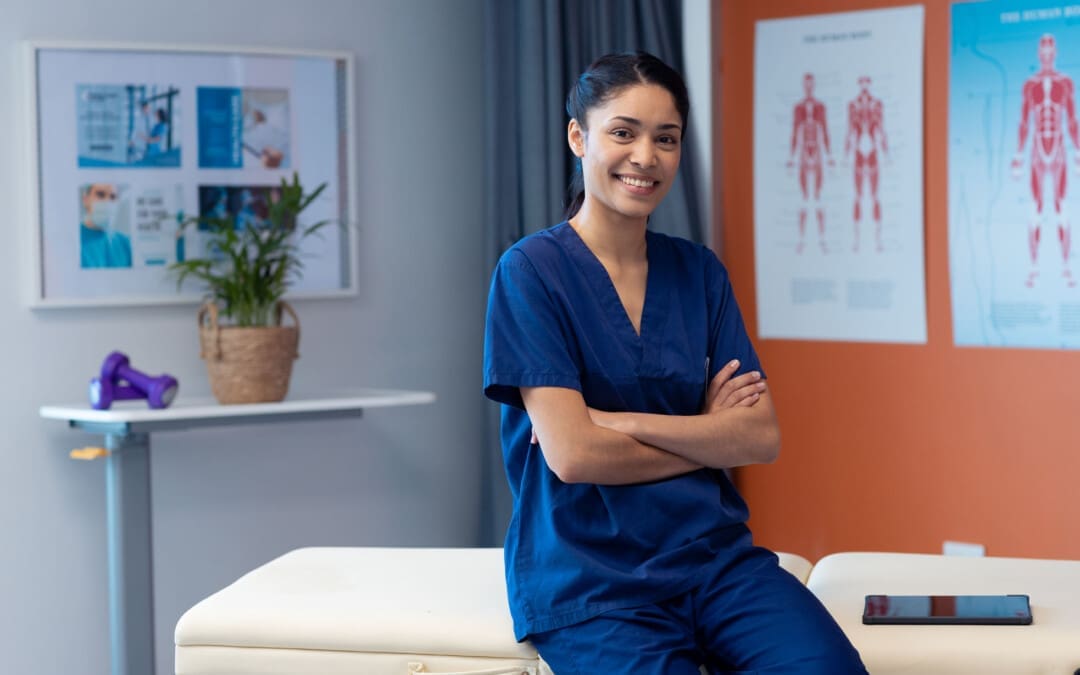
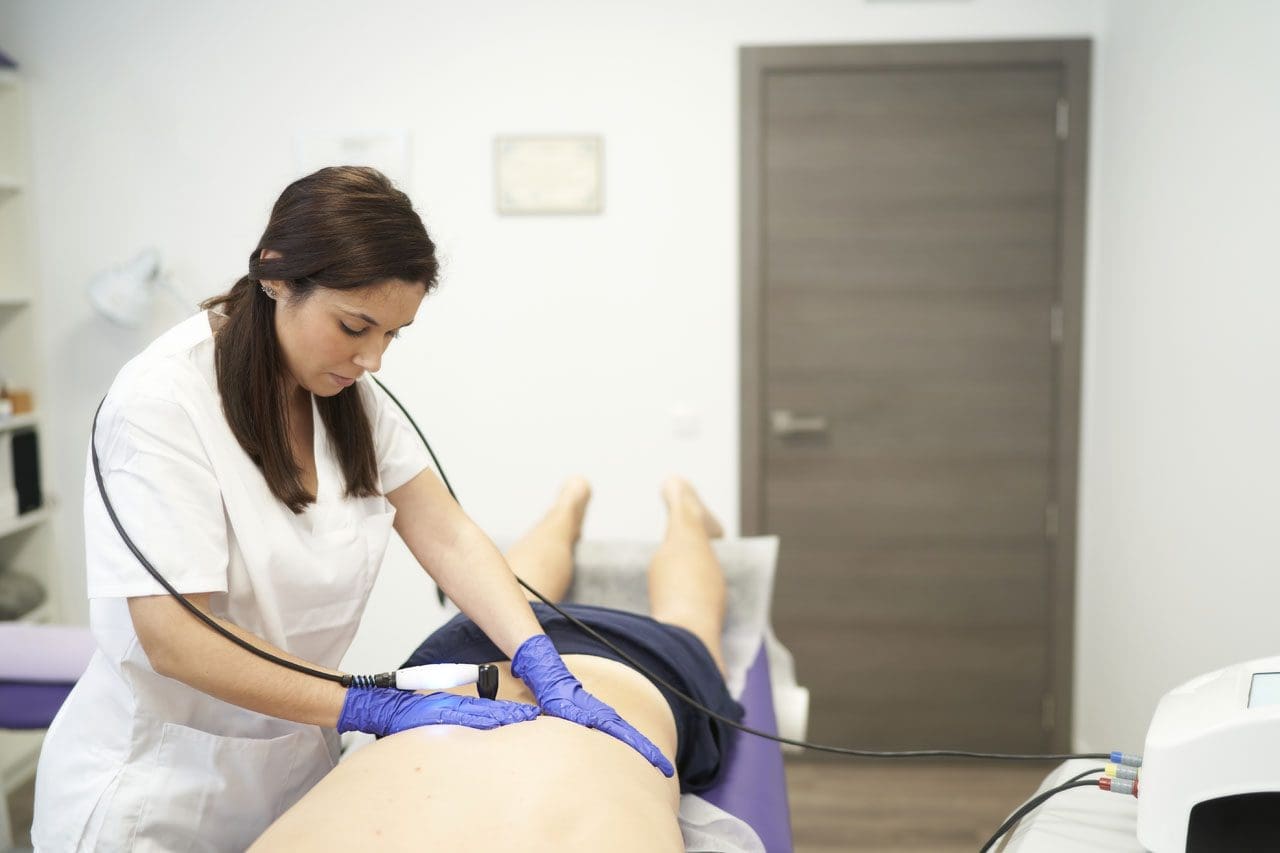

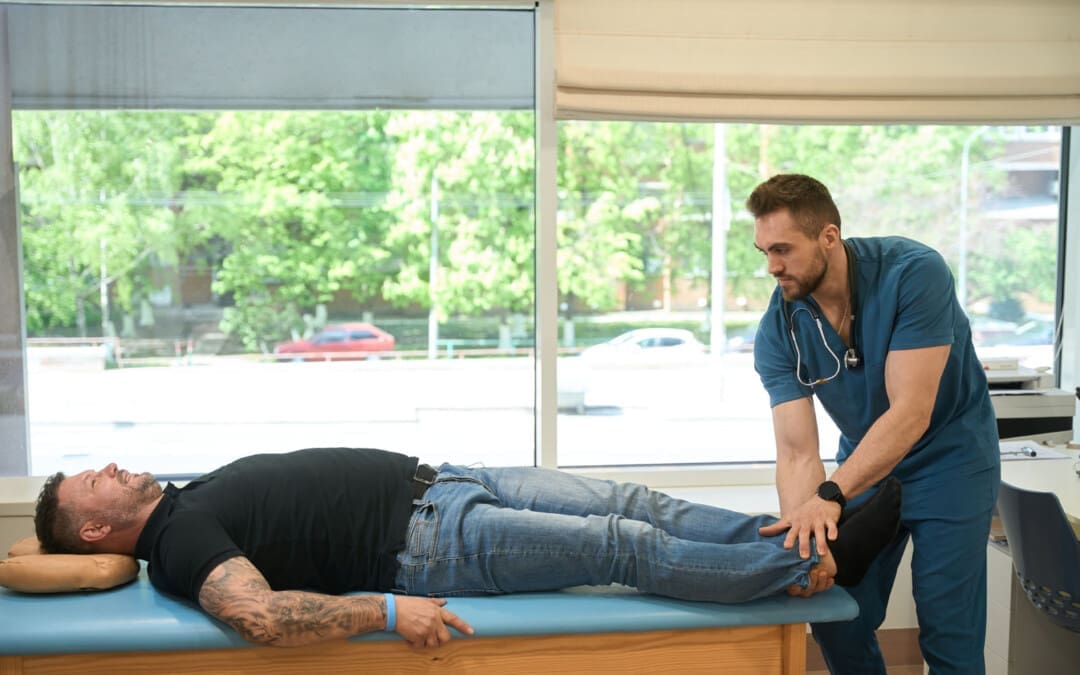
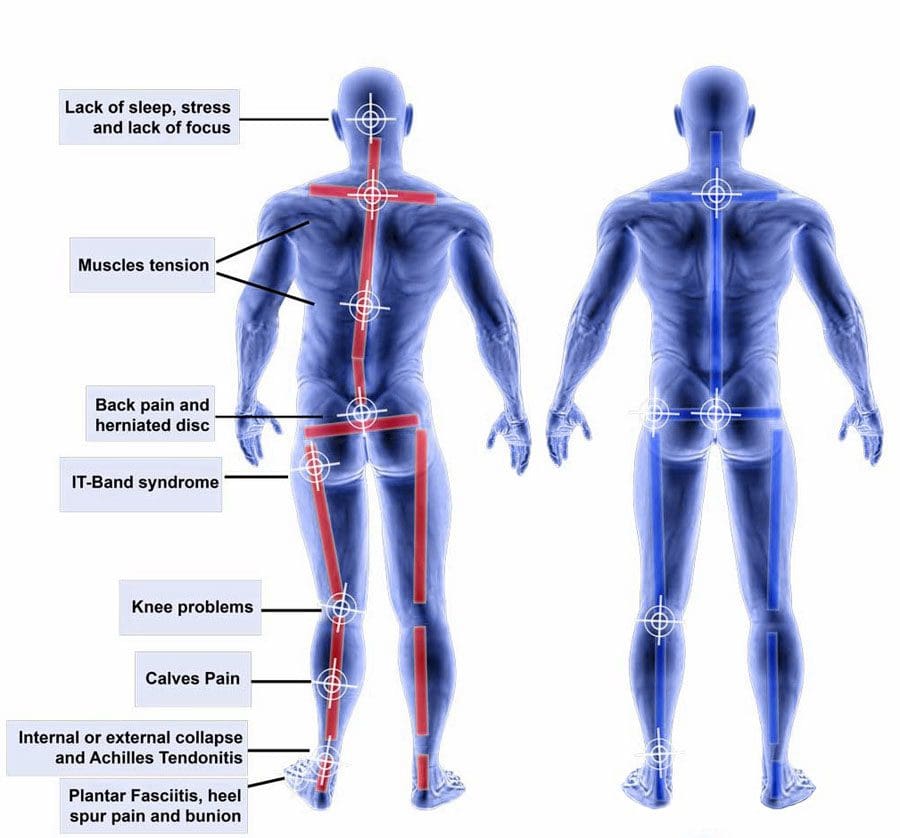
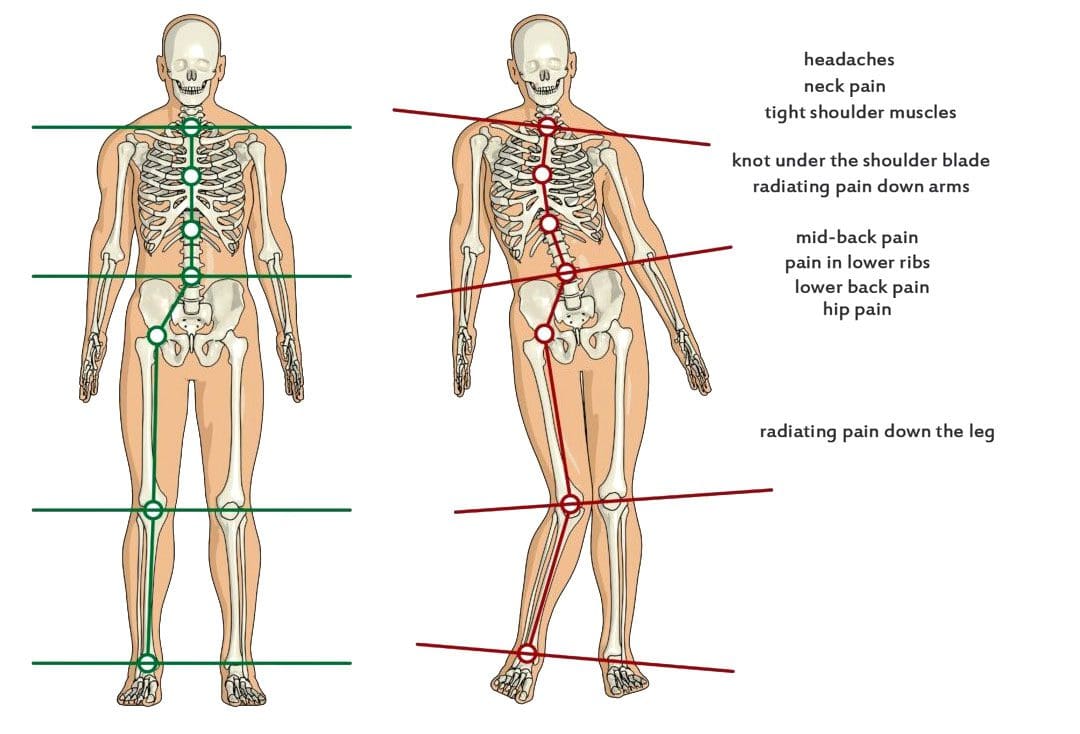 ប្រភេទស្បែកជើង និងផលប៉ះពាល់របស់ពួកគេលើខ្នង
ប្រភេទស្បែកជើង និងផលប៉ះពាល់របស់ពួកគេលើខ្នង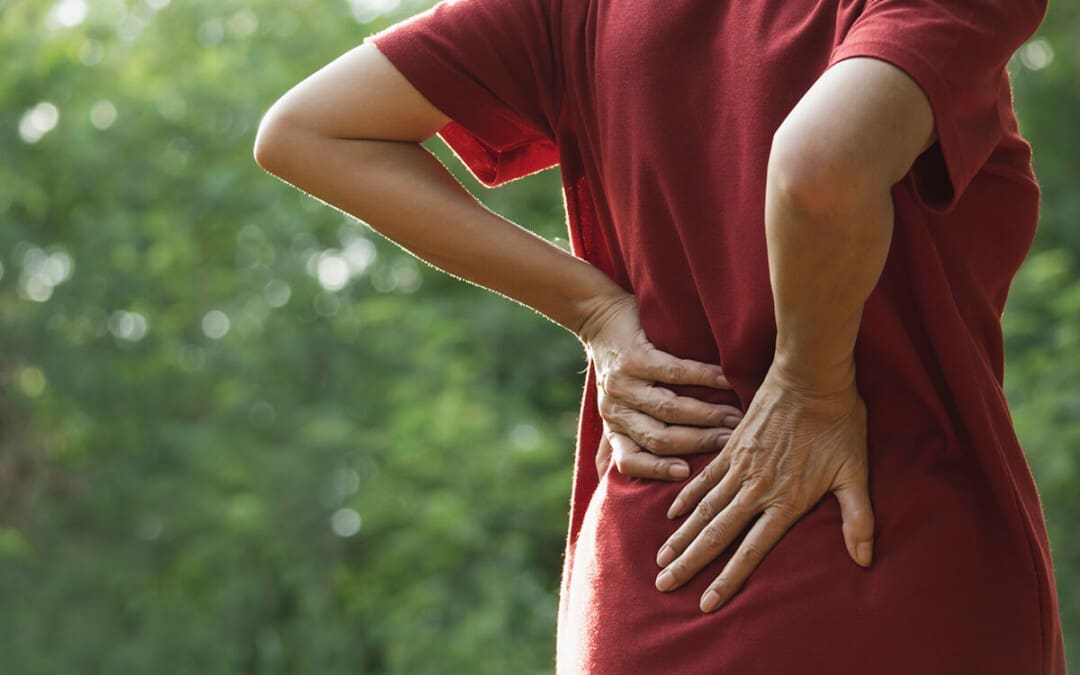
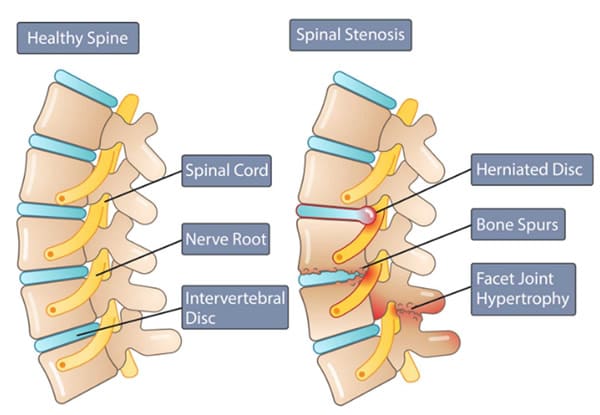
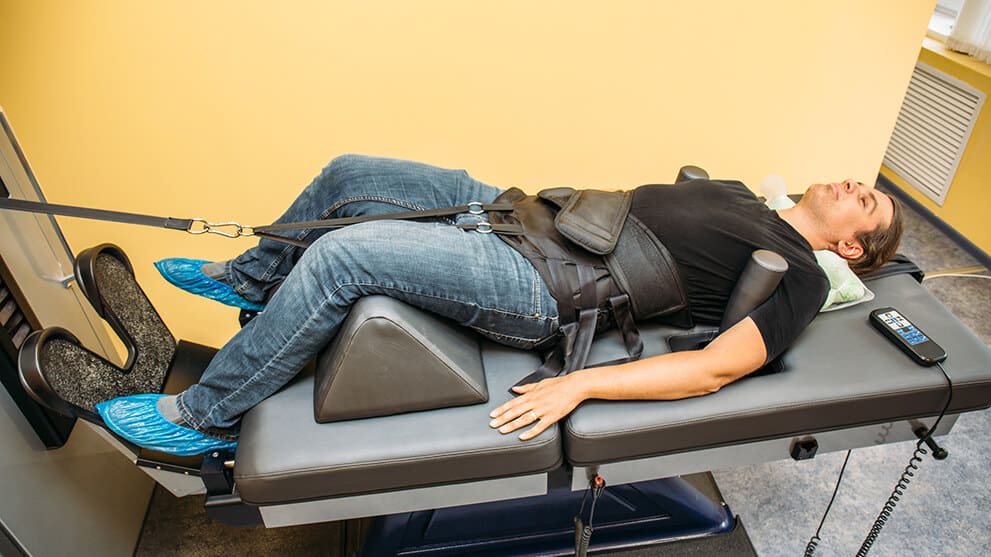
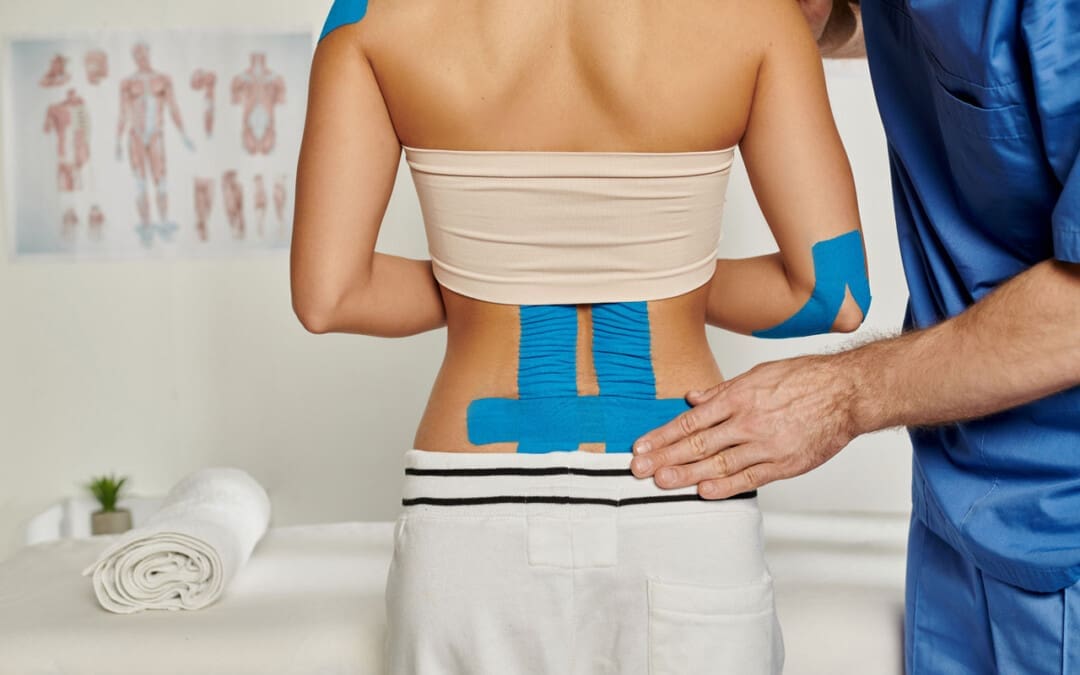
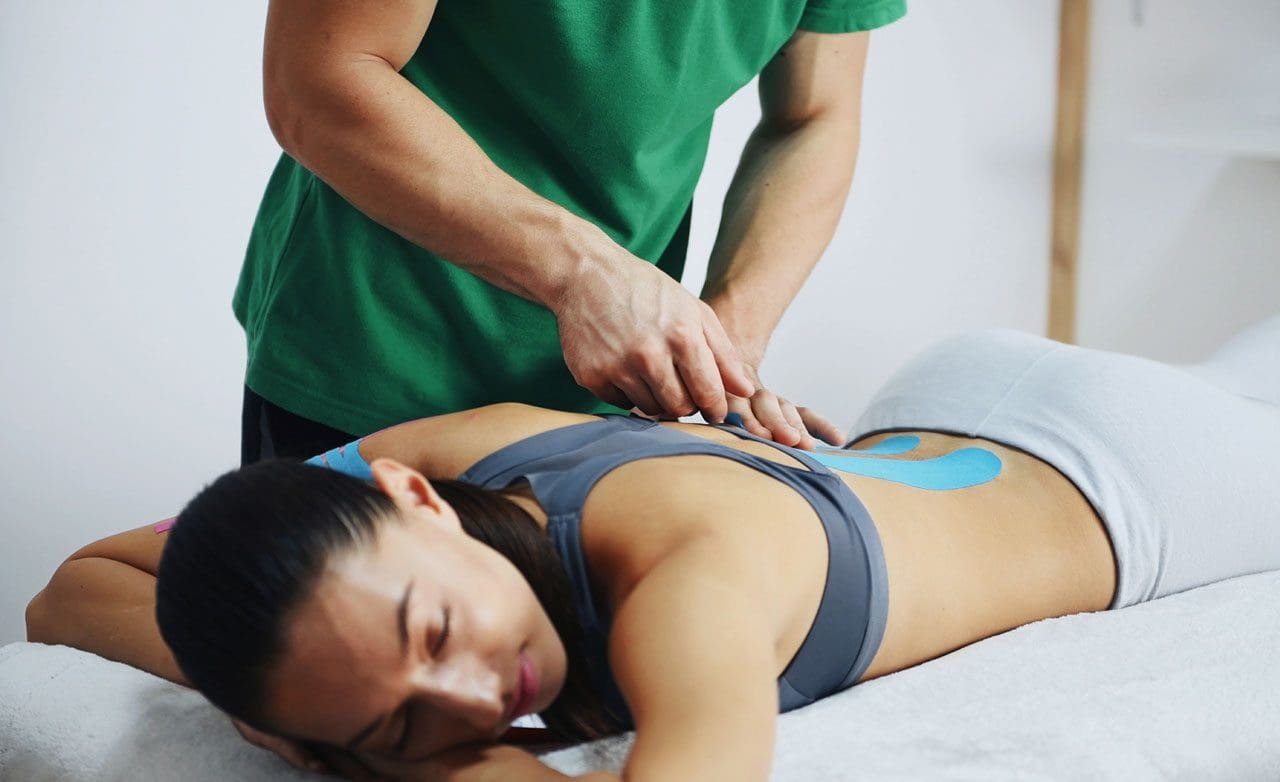
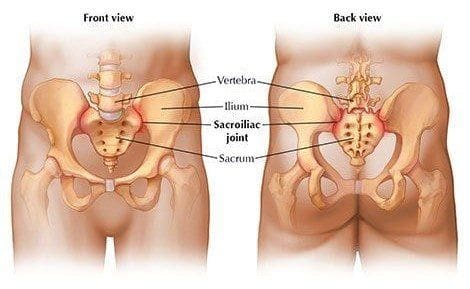 ជំហានការចាប់ផ្តើម:
ជំហានការចាប់ផ្តើម: